
- Gift Certificates
- View all Rooms
- Southern Breakfasts
- Sippin’ & Nibblin’ Hour
- Check Availability / Rates
- Policies / FAQ
- Credit Card Privacy Policy
- Top Local Eats

- Photography
- Media & Awards

The Twelve Oaks is now open book your dream room today
The home that inspired Twelve Oaks in Gone with the Wind is now reopen! We plan to offer historic tours of the mansion and grounds making this the only antebellum home of this size that you can tour in the Atlanta area. Explore Georgia named the Twelve Oaks as one of the top antebellum sites to see in Georgia.

An Award Winning Inn

Come Stay With US
The mansion was completely renovated in 2012 and updated with every modern convenience including private luxury bathrooms, remote control fireplaces in every room, and WIFI. Come stay with us and take advantage of a phenomenal opportunity to stay in of one of the south’s crown jewels as all of our suites are located inside the mansion. Stay in a room with a luxurious spa tub that has aromatherapy and chromo-therapy or choose a room with a luxury copper bateau tub. In one of the grand suites, you can even experience an original ribcage shower, the kind installed in places like the Buckingham palace! We plan to spoil you rotten and you’ll never want to leave the comfortable plush beds with Egyptian cotton sheets or the soft Turkish robes! Included with your stay, join us in the mornings for the fresh home-cooked and locally sourced southern breakfast and then in the evenings for Southern Sippin’ and Nibblin’ Hour. Then enjoy our complimentary turndown service that includes chocolate truffles and cold waters.
Coming Soon! We will be offering individual tours or group tours featuring the latest technology. Using an iPad, you are guided room by room while learning the rich history and the stories behind one of the south’s greatest antebellum treasures.
Explore Covington
Covington is known as The Hollywood of the South because of the many movies and television shows filmed here. But that’s not all! Explore the historic town square with the many different shops and restaurants or take a walking tour of the many historic antebellum homes. Covington is located in the Atlanta Metro area and is conveniently located with easy access to all Atlanta offers. Our central location makes it possible to explore Atlanta, Madison, Athens, and more!
Special Events
There is plenty of room outside and inside to accommodate small or large events up to 200! With over 11,000 square feet in the mansion and over 3 acres of grounds with a pergola and a gazebo, a pool, a pond, huge oak trees, and a huge deck, it is perfect for your wedding, or event. The Twelve Oaks has received numerous awards for its events including Best of The Knot and The WeddingWire Couples Choice Award. Whether it is a small intimate dinner a corporate retreat or a large wedding, THe Twelve Oaks will provide an unforgettable experience and memories to last a lifetime.
Great place, great location, just great!
This is a truly amazing property which is full of amazing history. The staff were all so friendly and helpful. It is literally a 5 min walk into Covington with plenty of restaurants to choose from. The breakfasts are traditional southern fare so bring your biggest appetite! The cheese and wine at 5pm is a nice touch and really gives you a chance to mingle if you wish. This was our first B&B experience in the USA and definitely won't be the last. nick1981 Poole, England
Visit Us Today
- (843) 628-2006
- [email protected]

A Journey Through Savannah’s Antebellum Homes and Estates
Embark on a fascinating exploration into the heart of Savannah, Georgia , where the grandeur of Antebellum Homes Savannah captures the essence of a bygone era. These historic homes in Savannah , Georgia , stand as proud monuments to historic preservation and the enduring allure of Southern architecture . As you tread along the cobblestone streets and pass beneath the Spanish moss, each estate reveals a chapter of the past, with guided tours of Savannah providing a voice to these timeless narratives.
Whether you’re standing before the elegant columns of the Owens-Thomas House & Slave Quarters or admiring the intricate ironwork of the Davenport House Museum, these homes are bastions of culture and history. The preservation efforts in Savannah are not mere acts of nostalgia; they are a collective commitment to safeguarding the architectural beauty and historical integrity of the city for future generations to experience firsthand.
So, prepare yourself for a voyage through history as you step into the lives of those who walked these halls in the Antebellum South. From the strategic headquarters of General Sherman at the Green-Meldrim House to the mid-nineteenth-century grandeur of the Andrew Low House, you are about to witness the legacy that each of these estates has inscribed upon Savannah.
Key Takeaways
- Discover the rich history behind Savannah’s Antebellum homes and their significance in Southern architecture .
- Gain insights into the historical fabric of Savannah through the stories told by the Owens-Thomas House & Slave Quarters and other historic estates.
- Appreciate the critical role of historic preservation in maintaining the beauty and cultural heritage of these storied homes.
- Explore the depths of Georgia’s Antebellum period with educational and engaging guided tours across Savannah.
- Experience the personal tales and significant events of the Civil War era that are etched into the walls of Savannah’s majestic homes.
Exploring the Historical Allure of Antebellum Homes Savannah
As you begin exploring Savannah history , you’ll quickly discover the city’s architectural treasures, prominently featuring Antebellum homes that reflect a period of Southern elegance. These historical landmarks, spared from the brink of demolition, offer a poignant glimpse into the rich past of Savannah architecture . Take a step back in time with guided tours Savannah provides, allowing you to walk the corridors once traversed by the figures who shaped the South.
Embark on a journey to the acclaimed Davenport House Museum , which showcases not only the architectural finesse of its era but also tells the story of historic preservation success. Through the curation of various tours, you have the opportunity to experience the notable Savannah attractions from an intimate perspective, courtesy of reputable guides like the Old Town Trolley Tours .
Not to be overshadowed in grandeur, the Andrew Low House stands as a beacon of antebellum life, offering rich accounts of the city’s cultural fabric. Further intensifying the historical narrative, the Green Meldrim House captivates with its Gothic Revival style and critical wartime role, bringing to life a pivotal chapter in Civil War history .
Perhaps the most illustrious of these homes is the Owens-Thomas House , not merely an epitome of Regency architecture but also an educational center that brings focus to Savannah’s sobering history of slavery. Here visitors confront the stark contrast between the refined beauty of the estate and the austere existence of the enslaved people who lived there.
- Discover the pristine restoration of these iconic residences.
- Witness the blend of luxury and legacy inherent in each mansion.
- Engage with authentic Southern stories shared by knowledgeable tour guides.
Whether you’re interested in architecture, history, or simply the allure of a city frozen in time, Savannah’s meticulously preserved Antebellum homes offer something for every curious traveler. As you traverse the historic district, you are not simply sightseeing; you are walking through living history, one cobblestoned street at a time.
The Role of Preservation in Savannah’s Historical Homes
The charming city of Savannah, Georgia , is renowned for its rich tapestry of history, woven into the fabric of its architectural landscape. Here, every historic home stands as a monument to the tireless efforts of those who have dedicated themselves to the cause of historic preservation . Journey through Savannah’s cobblestone streets, and you’ll be transported back in time, thanks to the vigilant protection and restoration of its storied past.
Imagine strolling through the streets of this historic district, with stunning reminders of a bygone era at every turn. These landmarks bear witness to the success of historic preservation groups, which have passionately combated the ravages of time and modernization to maintain Savannah’s storied character. Through their actions, these residences not only tell the tales of their original inhabitants but also echo the broader narrative of American history and culture.
- Harper Fowlkes House: A vision of Greek Revival elegance, showcasing sumptuous antiques and tranquil gardens, preserved for future generations.
- William Scarbrough House: Once a prominent maritime abode, now seamlessly integrated with Savannah’s maritime heritage as part of the Ships of the Sea Maritime Museum .
- Historic Savannah Foundation: A sentinel of Savannah’s architectural and cultural integrity, credited with spearheading the protection of these historical treasures.
When you engage in Savannah sightseeing , you’re not merely a visitor – you become a part of the living history that is preserved within the walls of the city’s iconic homes. The legacy of Savannah’s historic homes is palpable, grounding you in an authentic experience that illustrates a commitment to safeguarding Southern heritage.
Unveiling Southern Architecture at the Andrew Low House
Discover the magnificence of Southern architecture as you step into the historic Andrew Low House, a treasure among the Antebellum Homes Savannah boasts. This Italianate mansion, set within the idyllic environs of Savannah’s historic district, transports you back to the city’s cotton-trading zenith in 1848. It’s an architectural jewel crafted for a self-made Scottish magnate and has since hosted figures of historical significance, including the venerable Robert E. Lee and the Earl of Roxbury.
Maintained by The National Society of The Colonial Dames of America in the State of Georgia, the Andrew Low House is more than a static relic; it’s a dynamic exhibition space, offering guided tours Savannah aficionados and novices alike revel in. Here’s what you can expect when you visit:
- Elegant Interiors: Behold rooms adorned with mid-19th century decor, reflecting the opulence and affluent lifestyle of Savannah’s former denizens.
- Rich History: Immerse yourself in stories from an era gone by, learning about the prestigious guests and the pivotal role the house played in Savannah’s cotton trade.
- Guided Tours: Knowledgeable guides bring the past to life, providing insights into the Italianate style and the cultural relevance of these enchanting Southern architectural masterpieces.
Whether you’re an architecture enthusiast, a history buff, or simply looking to experience a unique slice of the South, your visit to the Andrew Low House is guaranteed to be a highlight in your exploration of Savannah’s illustrious past.
The Cultural Tapestry of Savannah’s Historic Estates

As you delve into Georgia’s antebellum history and embark on Savannah sightseeing , you’ll find the city’s storied past etched within the walls of its historic homes in Savannah, Georgia . These homes are not mere structures; they are repositories of culture, each with its own narrative that contributes to the intricate tapestry of the South.
The Mercer-Williams House is synonymous with both splendor and suspense. Known for its pivotal role in the true-crime novel “Midnight in the Garden of Good and Evil,” this home offers more than just a tour; it’s an excursion into a world where history and literature collide. The home’s Italianate and Greek Revival architectural styles are a visual treat, highlighting the importance of aesthetic in the antebellum South.
Furthermore, the literary legacy of Savannah is splendidly captured in the Flannery O’Connor Childhood Home. Here, you’ll step into the space where one of America’s most formidable writers began her journey, with exhibits and guided tours illuminating her life and works. This home is a monument to O’Connor’s enduring influence on Southern Gothic literature.
- The Mercer-Williams House: Explore the opulence and literary significance.
- The Flannery O’Connor Childhood Home: A tribute to the celebrated author’s formative years.
These historic homes transcend time, allowing you to glimpse into a period when art and society were intimately interwoven with the everyday. As you explore these landmarks, take a moment to stand still; let the grandeur of antebellum aesthetics and the whispers of past literati envelop you, leaving an indelible mark on your understanding of Savannah’s historical grandiosity.
Savannah’s Artistic Heritage: The Birthplace of Juliette Gordon Low
As you explore the charming avenues of Savannah, don’t miss the opportunity to visit the Juliette Gordon Low Birthplace , a pivotal part of the city’s rich artistic and cultural heritage. This historic house is more than just a marvel of Savannah architecture ; it’s a shrine to the empowering legacy of the founder of the Girl Scouts of America . Nestled at the heart of Savannah, the birthplace at 10 East Oglethorpe Avenue serves as an inspirational landmark that connects the present to a time of transformation and social progress.
Intricately linked with the spirit of female empowerment, this well-preserved abode allows you to step into the shoes of the visionary Juliette Gordon Low. It’s here, within these walls, that she envisaged a community that would nurture and develop the skills of young girls, leading to the establishment of the Girl Scouts. As you wander through the preserved rooms, you are surrounded by a sense of history, echoed in the original furnishings of the Low family which have been carefully maintained, providing a window into the opulent lifestyle of 19th-century Savannah.
- Embark on a guided tour and let yourself be carried back to the era of Juliette Gordon Low, witnessing the very surroundings that shaped her pioneering outlook.
- Discover a timeless tale through exhibits featuring artifacts from the Girl Scouts’ rich history, including vintage uniforms and cherished memorabilia.
- Feel the influence of this national treasure that not only celebrates the life of a remarkable woman but also symbolizes Savannah’s contribution to women’s history in the United States.
Your visit to the birthplace of Juliette Gordon Low is more than just a sightseeing stop; it’s an immersive experience into the foundation of an organization that continues to empower young women globally. As the steward of this important piece of Savannah’s cultural tapestry, the Girl Scouts of America proudly invites you to celebrate the indomitable spirit and historic vision that sprouted from this classic example of Savannah’s architectural elegance.
Merging Maritime Past with Antebellum Grandeur at the Scarbrough House

When you step into the Scarbrough House, now famously housing the Ships of the Sea Maritime Museum , you are immediately transported to an era where Savannah, Georgia’s maritime prowess was as rich as its architectural allure. This emblematic Greek Revival mansion, originally owned by the illustrious steamship pioneer William Scarbrough, stands as a seamless blend of Savannah’s maritime history and the regal Antebellum period.
The Scarbrough House’s significance extends far beyond its walls. As a keystone among the historic homes in Savannah, Georgia , it represents not just the aesthetic zenith of Southern architecture but also the ambitious spirit of Savannah’s seafaring community. The home has been meticulously restored, ensuring its tales and treasures are well-preserved for future generations.
- Marvel at the museum’s extensive collection of ship models, each telling the story of the vessels that once navigated the Atlantic and beyond.
- Stroll through the gardens that echo the home’s grandeur and act as an oasis in the heart of the city.
- Immerse yourself in the wealth of maritime artifacts that reflect Savannah’s status as a pivotal seaport.
The Ships of the Sea Maritime Museum does more than showcase artifacts; it serves as an educational cornerstone, enlightening visitors about Savannah’s role in maritime trade and exploration. By visiting this treasured landmark, you’re not only exploring one of the prime Savannah attractions , but you’re also stepping aboard a journey through time, celebrating the confluence of naval achievement and Antebellum elegance that is unique to the character of Savannah.
Experience Savannah’s Living History Through Guided Tours
Have you ever wanted to stroll through the annals of time and witness the unfolding of history before your very eyes? Embarking on guided tours in Savannah does just that; offering a gateway to the past, these tours are your chance to truly connect with the Georgian spirit. Imagine exploring Savannah’s history through the stories and narratives that these walls have witnessed. It’s not merely about sightseeing—it’s about engaging with every corner that has a story to tell.
Picture yourself walking beside the grandeur of the Green Meldrim House , where you’ll hear tales of its occupation by General Sherman during the Civil War—a story riveting for both the history aficionado and the casual learner. Or, uncover the historic prowess of the Owens-Thomas House & Slave Quarters , an abode that provides a sobering glimpse into Savannah’s complex past. And let the narrative of the Scarbrough House carry you away into the city’s maritime saga, laden with the rich lore of seafaring days. Each narrated tour accentuates aspects that are as informative as they are fascinating, like the advent of indoor plumbing and the cultural legacy left by African slave quarters.
- Unearth stories of innovation and resilience at the Owens-Thomas House with its early plumbing marvels.
- Engage with the maritime chronicles and architectural splendor of the Scarbrough House.
- Delve into the Green Meldrim House’s Civil War history and its stunning Gothic Revival style.
As you traverse through these living monuments of Savannah, bear in mind that it’s not only about learning something new. It’s about exploring Savannah’s history , feeling the texture of the old walls, admiring the artistry of the antiques, and basking in the ambiance of times gone by. These vivid narrations and visible histories contribute to a rich amalgam, creating a fabric so textured, it’s as though history itself is narrating its tale. Savannah sightseeing through guided tours ensures a unique, multisensory remembrance that stands apart from the ordinary—turning your visit into an immersion in living history.
The Intriguing Legacy of Savannah’s Historic Homes as Attractions

As you stroll through the streets of Savannah, you’re not merely a passerby—you’re a traveler in time, engaging with the stories and spirits of the past. The historic homes in Savannah , Georgia, are more than just architectural delights; they are vestiges of history, narrating tales of courage, intrigue, and transformation that shaped this charming city.
Imagine walking through the Sorrel-Weed House , whose chilling stories have captivated audiences on “Ghost Hunters.” Or perhaps you’re drawn to the Mercer-Williams House, forever etched in the cultural fabric of Savannah through its depiction in the famous book and movie “Midnight in the Garden of Good and Evil.” These Antebellum Homes in Savannah stand as storied sentinels, attracting thousands of visitors yearning to explore their rich legacies.
- Antebellum Grandeur: Be enveloped by the grandiosity of the era, as you witness opulent Victorian furnishings and the detailed craftsmanship that speak of a bygone era’s elegance and sophistication.
- Educational Experience: Each home serves as a repository of knowledge, offering educational opportunities about Savannah’s role in American history, from its Antebellum prosperity to its pivotal moments in wartime.
- Cultural Narratives: Uncover the layered narratives of the city’s social evolution, from the struggle of enslaved individuals in the slave quarters to the societal shifts post-Civil War.
Whether you’re an architecture aficionado, a history buff, or simply in search of a story, the Savannah attractions of historic homes are a trove of treasures waiting to be discovered. Each visit peels back another page of Georgia’s storied past, inviting you to step into a living history that continues to captivate and inspire.
After Dusk: Exploring the Haunted Tales of Savannah’s Antebellum Homes
As twilight settles over Savannah, the historic district shrouds itself in an ambience ripe for ghostly encounters. Your adventure into the paranormal might lead you to the notorious Sorrel-Weed House , a pinnacle among the most haunted places in Savannah . Here, spirits of the past are said to loom in the shadows, inviting you to unearth the stories that echo through its halls.
On a Savannah ghost tour , the past will feel eerily present, as you navigate antebellum architecture under the cloak of darkness. The plaintive whispers of history resonate along the cobblestone streets, leading you from one haunted estate to another, each with its own spectral residents and somber tales.
- Discover the chilling lore surrounding the Mercer-Williams House, where tales of tragedy and the supernatural converge.
- Feel the cold breath of the unknown as you stand before the shadowy facade of the Madison Square residences.
- Walk in the footsteps of the daring and curious who have explored these haunts, seeking to connect with the spectral world.
Whether you’re a seasoned ghost hunter or simply inquisitive about the city’s darker side, these tours offer a spine-tingling perspective on the charm and mystery of Savannah after dusk.
Green Meldrim House: A Civil War Monument with a Twist

As you wander the historic streets of Savannah, a visit to the Green Meldrim House stands out as an essential experience for anyone with a passion for Civil War history and architectural beauty. This antebellum mansion, steeped in grandeur and mystery, opens its doors to reveal a past intertwined with pivotal wartime moments.
Built in the 1850s for Charles Green, a prosperous English cotton merchant, the Green Meldrim House is a showcase of the Gothic Revival style, complete with cast-iron decorative elements and striking crenelated parapets. However, it’s not just the architecture that captures the imagination; the house’s role during the Civil War is of equal note. As you step through the rooms where General Sherman once headquartered during the Union occupation of Savannah, you can almost hear the whispers of strategic war discussions reverberating off the walls.
After the war, the residence was acquired by the prominent Judge Peter W. Meldrim, adding layers of local judicial history to its already rich tapestry. The final twist in the narrative comes with the subsequent ownership by St. John’s Episcopal Church, lending a sense of tranquility and reflection to the history-laden atmosphere.
Your tour of the Green Meldrim House is more than mere Savannah sightseeing ; it’s a journey through time. You’re invited to:
- Explore the meticulously restored interiors, complete with period furniture and intricate details.
- Learn about the critical role this mansion played during one of the most tumultuous times in American history.
- Marvel at the ingenuity of antebellum architecture and design.
The Green Meldrim House is more than a landmark; it’s a witness to history, a work of art, and a treasure in the heart of Savannah, waiting for you to discover its secrets.
The Quaint Charm of Savannah Architecture at Owens-Thomas House
As you traverse the heart of Savannah, your journey uncovers the Owens-Thomas House & Slave Quarters, a paragon of Savannah architecture and an integral Savannah attraction. This historic site transports you to the zenith of the Antebellum era, with an aesthetic guided by English architect William Jay, whose visionary work emanates the elegance of Bath, England. The side veranda, boasting cast-iron acanthus scrolls, stands as a testament to times past, famously hosting the Marquis de Lafayette.
Within its walls lie a cornucopia of English Regency period furnishings, authentic Savannah textiles, and a stark reminder of the city’s layered history—the preserved slave quarters. These domestic spaces lay bare the reality of life in the 19th century while punctuating Savannah’s commitment to cultural preservation. Your visit to this National Historic Landmark underscores a vast historical narrative, woven seamlessly into the fabric of Savannah’s vibrant tapestry.
- Explore the sophisticated design rooted in international influence and historical significance.
- Witness the evolution of Savannah’s socio-economic landscape through culturally emblematic architecture.
- Appreciate the diverse collection of period furnishings and textiles that offer a portal into the affluence of the English Regency era.
- Contemplate the poignant history of the slave quarters, providing insight into the complexities of the Antebellum South.
Through the Owens-Thomas House & Slave Quarters, Savannah maintains its allure not only as a beacon of antebellum heritage but also as a repository of narratives that continue to shape the city’s modern identity.
Embarking on an odyssey through Savannah’s historical canvas, you’ve revealed the architectural treasures and the cultural narrative of Georgia’s esteemed Antebellum period. Each home narrates a tale, steeped in heritage, that beckons travelers to partake in exploring Savannah’s history . From the stately grandeur of the Owens-Thomas House to the poignant realities etched within the slave quarters, these landmarks are a vibrant homage to the bygone era of Southern elegance and strife.
As you weave through the city’s past, consider making your journey even more memorable at the Savannah Lakes RV Resort in Hardeeville, SC. Here, comfort meets history, offering a serene retreat that echoes the warm embrace of Southern hospitality. Perfectly positioned for those who wish to extend their travel to Savannah , the resort serves as an ideal basecamp as you continue to uncover the mesmerizing tapestry of this enchanting locale.
Your voyage through the historic homes of Savannah has far surpassed mere sightseeing. It has granted you a poignant connection to American heritage, spotlighting the tireless efforts of preservationists and the cities enduring spirit. Each visit to these storied estates fosters a renewed appreciation for their legacy, ensuring that the beauty and lessons of the Antebellum South are treasured for generations to come.
What are some notable Antebellum homes in Savannah?
Savannah is home to several renowned Antebellum homes including the Owens-Thomas House & Slave Quarters, the Davenport House Museum, the Green-Meldrim House, the Andrew Low House, and the Mercer-Williams House, among others.
Can you take guided tours of the historic homes in Savannah?
Yes, many of Savannah’s historic homes offer guided tours. For example, the Andrew Low House and the Davenport House Museum provide tours led by historians who offer in-depth knowledge of the homes’ histories and architecture.
Why is historic preservation important in Savannah?
Historic preservation in Savannah is crucial for maintaining the integrity of the city’s cultural heritage, its architecture, and its historical narratives. Organizations like the Historic Savannah Foundation have been pivotal in conserving these sites for future generations.
What architectural styles are represented in Savannah’s Antebellum homes?
Savannah’s Antebellum homes display a variety of architectural styles, including Regency, Greek Revival, Gothic Revival, and Italianate, reflecting the rich diversity of the city’s architectural heritage.
How does the Andrew Low House contribute to Savannah’s Southern architecture?
The Andrew Low House, built in 1848, is a prime example of Italianate style architecture. It offers insight into the luxurious lifestyles of Savannah’s 19th-century elite, with its opulent interior and significant historical guests.
What is the significance of the Juliette Gordon Low Birthplace in Savannah?
The Juliette Gordon Low Birthplace is a historic site that celebrates the life of the founder of the Girl Scouts of America . It showcases her contributions to women’s history and the community, as well as featuring original family furnishings.
What does the Scarbrough House represent in Savannah’s maritime history?
The Scarbrough House represents the merger of Savannah’s maritime history and antebellum grandeur. It was built for William Scarbrough, an important figure in maritime trade, and is now home to the Ships of the Sea Maritime Museum which exhibits marine art and ship models.
Are there any haunted Antebellum homes in Savannah?
Savannah is known for its ghostly lore, and some of its Antebellum homes, like the Sorrel-Weed House , are reputed to be haunted. These homes often offer ghost tours that provide a thrilling perspective on Savannah’s eerie past.
What role did the Green Meldrim House play during the Civil War?
The Green Meldrim House played a significant part in America’s Civil War history , serving as General Sherman’s headquarters when the Union army occupied Savannah. It offers visitors a look into its Civil War and Gothic Revival architecture.
How does the Owens-Thomas House showcase Savannah architecture?
The Owens-Thomas House is a stunning example of English Regency architecture designed by William Jay. It features impressive architectural details such as wrought iron balconies and a historically significant carriage house with one of the earliest urban slave quarters attached to a house museum.
Source Links
- https://visitsavannah.com/list/9-historic-homes-savannah
- https://www.gpsmycity.com/tours/historical-houses-walking-tour-3023.html
- https://www.thisismysouth.com/historic-homes-in-savannah/

- 170 Savannah Lakes Drive Hardeeville, SC 29927
- Privacy Policy
- Terms & Conditions
- Accessibility Statement
- Cancellation Policy
© 2024 Contemporary Resorts & Residences | This property is managed by CRR Hospitality | All Rights Reserved. RV Resort Website Designed By Insider Perks, Inc.
Cookie banner
We use cookies and other tracking technologies to improve your browsing experience on our site, show personalized content and targeted ads, analyze site traffic, and understand where our audiences come from. To learn more or opt-out, read our Cookie Policy . Please also read our Privacy Notice and Terms of Use , which became effective December 20, 2019.
By choosing I Accept , you consent to our use of cookies and other tracking technologies.
Share this story

Exploring the architectural gems along Georgia’s Antebellum Trail
Reaching from Athens to Macon, within a couple hours of Atlanta, the trail offers remarkable homes and sites for architecture aficionados and history buffs
Despite Sherman’s infamous March to the Sea, which resulted in almost total destruction from Atlanta to Savannah, some of Georgia’s small towns escaped the torches of Union soldiers.
The Peach State, in fact, is fortunate to retain some of its most notable antebellum structures, which architecture fans can tour as part of Georgia’s Antebellum Trail.
The trail runs 100 miles through seven historic communities: Athens, Watkinsville, Madison, Eatonton, Milledgeville , Old Clinton, and Macon.
Along the way, you’ll see many fine examples of Greek Revival and other antebellum structures, from modest cottages to lofty estates. Several homes and sites are museums you can tour; others are available to admire from a distance.
To fully enjoy these architectural gems, schedule a few days for exploring their respective towns. It actually makes no difference where you start, but to help you plan, check out these proposed itineraries .
The Georgia’s Antebellum Trail website also provides plenty of information on museum hours, annual pilgrimages, and special events that take place along the trail.
For an idea of what the trail offers, check out this mapped preview of notable homes and sites.
Church-Waddel-Brumby House
Believed to be Athens’ oldest surviving residence, this home was built in 1820 for Alonzo Church, a former president of the University of Georgia. A restored Federal-period house, the home now serves as the Athens Welcome Center, where you can find more information on touring the city’s four antebellum house museums.
- Open in Google Maps
:no_upscale()/cdn.vox-cdn.com/uploads/chorus_image/image/65912618/Brumby_House.0.jpg)
TRR Cobb House
Built circa 1842 in Athens, the T.R.R. Cobb House stands apart from traditional antebellum architecture thanks to the octagonal wings that flank the main structure. One of those wings served as the office of T.R.R. Cobb, a lawyer who cofounded the UGA law school and principal author of the Confederate Constitution.
:no_upscale()/cdn.vox-cdn.com/uploads/chorus_image/image/65912619/trr_cobb_house_credit_cara_pastore.0.jpg)
Taylor-Grady House
A fabulous example of Greek Revival architecture, the Taylor-Grady House in Athens was constructed circa 1844 and served as the home of Henry Grady, noted editor of The Atlanta Constitution and namesake of UGA’s journalism school. The home’s 13 columns represent the original American colonies.
:no_upscale()/cdn.vox-cdn.com/uploads/chorus_image/image/65912620/Taylor_Grady_House.0.jpg)
Ware-Lyndon House
An Italianate mansion built circa 1850 by Edward R. Ware, the Ware-Lyndon House in Athens showcases some of the most notable interior design features of the era. These include the 19th-century faux graining and murals on the walls, the shell in the decorative cornice plaster work, and the matching set of furniture in the front parlor.
:no_upscale()/cdn.vox-cdn.com/uploads/chorus_image/image/65912621/Ware_Lyndon.0.jpg)
Eagle Tavern Museum
Located in the heart of Watkinsville, the Eagle Tavern Museum was built in the late 1700s, becoming a stagecoach stop and tavern in 1801. Situated across the street from the county courthouse, it welcomed many local residents as well as visitors.
While in Watkinsville, check out the Elder Mill Covered Bridge. Although it wasn’t built until 1897, covered bridges are always worth a visit.
:no_upscale()/cdn.vox-cdn.com/uploads/chorus_image/image/65912622/Eagle_Tavern_Museum.0.jpg)
Heritage Hall
Built in 1811 in Madison by Dr. William Johnston, Heritage Hall contains 14-foot ceilings, pocket doors separating the parlors (the back parlor is outfitted as the formal dining room), and, in the girl’s bedroom, a unique motif carved into the mantel.
Speaking of carvings, be sure to check out the many carvings in the window panes. (Apparently, the women in the house wanted to verify their diamonds were real.)
Those who experience otherworldly presences may have an ethereal encounter in the Ghost Bedroom, too.
:no_upscale()/cdn.vox-cdn.com/uploads/chorus_image/image/65912623/Heritage_Hall.0.jpg)
Rogers House Museum
Exhibiting Piedmont Plain-style architecture, Rogers House was constructed in 1809 by Reuben Rogers in Madison. Designed as a two-over-two structure, the home also has a back shed addition thought to have been added around 1820. The house is depictive of middle-class living during the 1800s.
:no_upscale()/cdn.vox-cdn.com/uploads/chorus_image/image/65912624/Copy_of_RogersHouse2.0.jpg)
Rose Cottage
Next door to Rogers House, Rose Cottage was the home of Adeline Rose, who built the home in 1891 for $100. Born into slavery, Rose at some point bought or received her freedom, and went on to earn a living by taking in washing and ironing at 50 cents a load. Not much is known of her life, but the home does include some of her personal possessions, including a quilt on the bed.
:no_upscale()/cdn.vox-cdn.com/uploads/chorus_image/image/65912625/rose_cottage.0.jpg)
Panola Hall (Sylvia’s House)
Constructed in 1854 in Eatonton, Panola Hall originally served as a town home for Henry Trippe, who owned a plantation. Doric columns and pilasters line the front of the Greek Revival house, which claims to have its own ghost.
The story goes that a woman, Sylvia, jumped off the balcony after learning of her fiancé’s death in the Civil War. However, she only seems to reveal her presence to those she believes to be her social equal.
:no_upscale()/cdn.vox-cdn.com/uploads/chorus_image/image/65912626/Panola_Hall.0.jpg)
Reid-Greene-Lawrence-Sichveland House
Built over the course of seven years, the Reid-Greene-Lawrence-Sichveland House is an 1855 three-story Greek Revival home featuring hand-carved Corinthian capitols, plaster medallions, wood graining, and marbleizing.
While Eatonton has no house museums, visitors can take in the antebellum architecture courtesy of the Historical Walking Tour. Stop by The Plaza Arts Center, where you can pick up a walking tour brochure at the Welcome Center. And, although not antebellum in nature, be sure to visit the Uncle Remus Museum.
:no_upscale()/cdn.vox-cdn.com/uploads/chorus_image/image/65912627/Reid_Greene_Lawrence.0.jpg)
Andalusia: The Home of Flannery O'Connor
Famous as the home of author Flannery O’Connor from 1951 to 1964, Andalusia Farm in Milledgeville had been constructed a hundred years earlier in 1850. Today, the home is outfitted to reflect the era’s décor and setup during O’Connor’s time here.
Since Georgia College and State University took over the property, a concerted effort to bolster the house as a museum received a boost when many of O’Connor’s original possessions were found in storage and are now on display.
:no_upscale()/cdn.vox-cdn.com/uploads/chorus_image/image/65912628/HHL_Milledgeville_Andalusia_Welty001_medium.0.jpg)
Rose Hill at Lockerly Arboretum
Built in Milledgeville in 1852 by plantation owner Daniel Reece Tucker, Rose Hill epitomizes the Greek Revival style of architecture. It landed a spot on the Natural Register of Historic Places in 2017 because it embodies almost all of the architectural style’s identifying features. Think prominent columns, stucco-clad exterior, symmetrical front façade, low-pitched hipped roof, and double-hung six-over windows. The interior also is reminiscent of the Georgian house style.
Rose Hill sits on the grounds of Lockerly Arboretum, a 50-acre garden open to the public.
:no_upscale()/cdn.vox-cdn.com/uploads/chorus_image/image/65912629/HHL_Milledgeville_LockerlyArboretum001_medium.0.jpg)
Georgia's Old Governor's Mansion
A prime example of High Greek Revival architecture, the Old Governor’s Mansion served as the home of Georgia’s governors from 1838 to 1868 during Milledgeville’s tenure as the state capital. During his March to the Sea, Sherman occupied the building on November 23, 1864, claiming it as a “prize.”
:no_upscale()/cdn.vox-cdn.com/uploads/chorus_image/image/65912630/Millegeville_GovMans004_medium.0.jpg)
Johnston–Felton–Hay House
Also known as the Hay House, this Greek Revival home was completed in 1859 on Georgia Avenue overlooking downtown Macon. The elaborate exterior is complemented by equally impressive luxury inside, with indoor plumbing, an elevator, and, for the time, a state-of-the-art ventilation system.
:no_upscale()/cdn.vox-cdn.com/uploads/chorus_image/image/65912631/Hay_House.0.jpg)
The Cannonball House
Built in 1853, this Greek Revival home in Macon actually was not struck by a cannonball during the Civil War as first thought. Decades later, it was determined the home was actually hit by a Hotchkiss shell during Stoneman’s Raid in 1864. However, “The Shell House” doesn’t have the same ring to it.
In addition to the home, visitors can see the original brick kitchen around back.
:no_upscale()/cdn.vox-cdn.com/uploads/chorus_image/image/65912632/Cannonball_House.0.jpg)
Sidney Lanier Cottage
A Victorian cottage built circa 1840 in Macon, this home is well-known as the birthplace of poet, musician, Civil War soldier, mathematician, and linguist Sidney Clopton Lanier. Listed on the National Register of Historic Places, the home includes a historic formal garden and lovely patio.
:no_upscale()/cdn.vox-cdn.com/uploads/chorus_image/image/65912633/Sidney_Lanier_Cottage.0.jpg)
Loading comments...
Site search.
- Los Angeles
- San Francisco
- Archive.curbed.com
- For Sale in Atlanta
- For Rent in Atlanta
- Curbed Comparions
- Neighborhoods
- Development News
- Construction News
- Architecture
- Transportation
- Historic Preservation
Budget-Friendly Getaway
A soul-inspiring adventure.

Wellness Wednesdays
Spring sip and shop, the full event calendar, where to stay, where to dine.
- Architecture
Bellevue, a stately antebellum home, was built between 1852 and 1855 by Benjamin Harvey Hill for his wife, Caroline Holt Hill. It is a significant example of the “domesticated temple” form of Greek Revival-style architecture popular in the antebellum South. Many dignitaries, including Confederate President Jefferson Davis, were entertained there.
Located in historic downtown LaGrange, Georgia, Bellevue became the home of the LaGrange Woman’s Club in 1942 when the Fuller E. Callaway Foundation presented the home to the club. Bellevue is a National Historic Landmark.
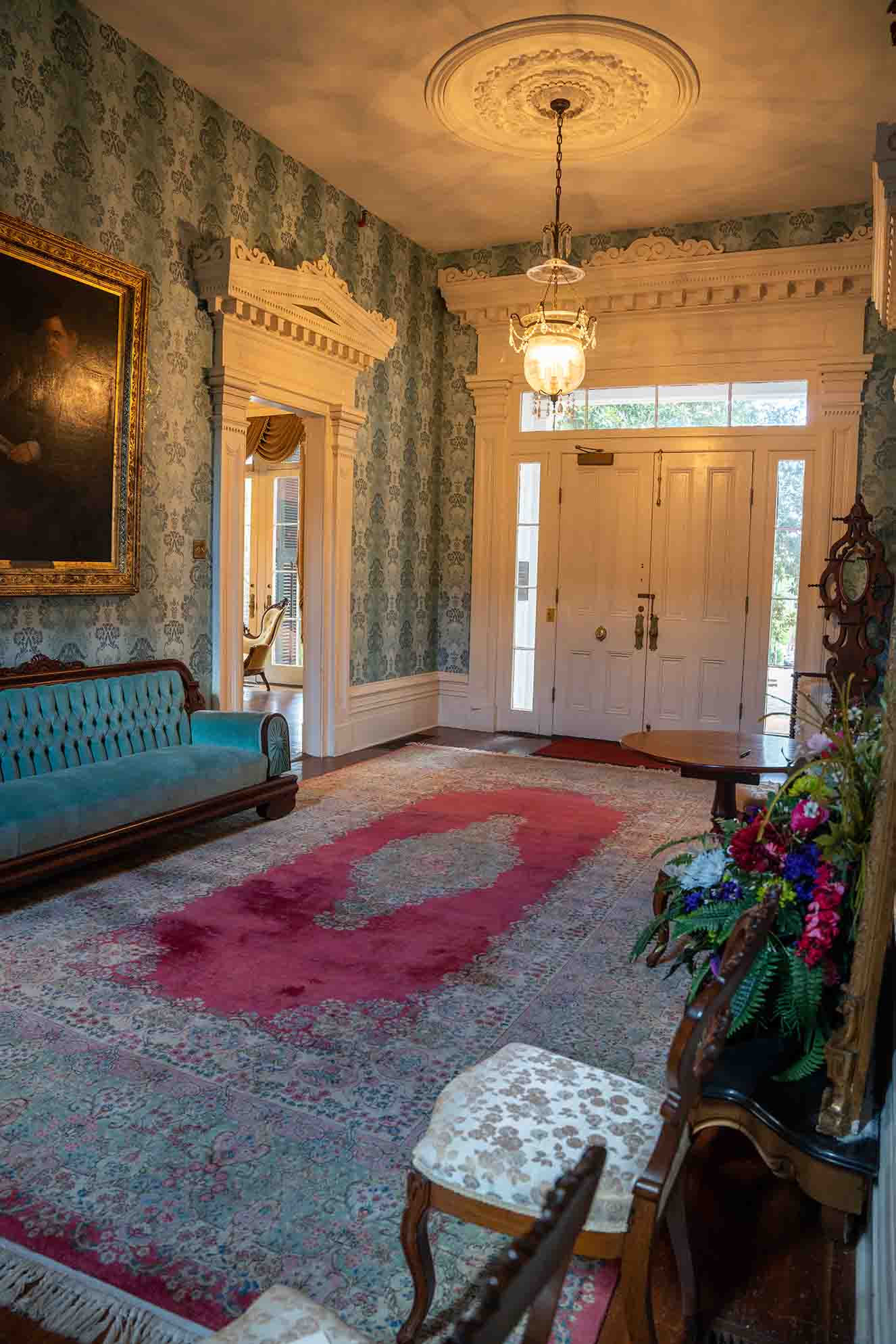
SEASON BEST ENJOYED
Insider tips.
- As you explore Bellevue, remember that it was once a 1,200 acre plantation estate!
- When the estate was larger, Bellevue’s gates were located on Broad Street. The gates were removed in 1905 to convert the carriage drive to a residential street (now Ben Hill Street).
- These gateposts now reside at LaGrange College. Interestingly, the gates are identical to the gates at The White House in Washington D.C. because they were ordered from the same catalog.
LAGRANGE, GEORGIA
There’s a lot to explore in LaGrange, so we’ve curated these trip ideas and itineraries to help you plan an unforgettable getaway!
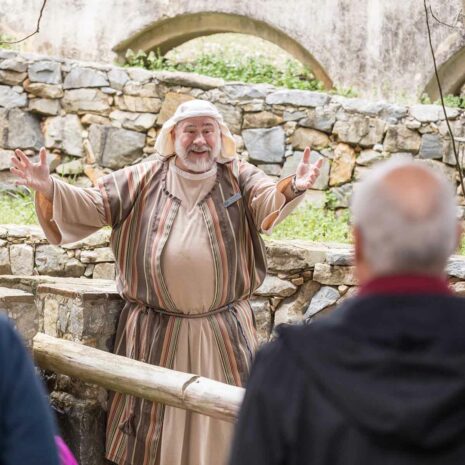
Follow your faith to LaGrange, Georgia

Fun For The Whole Family
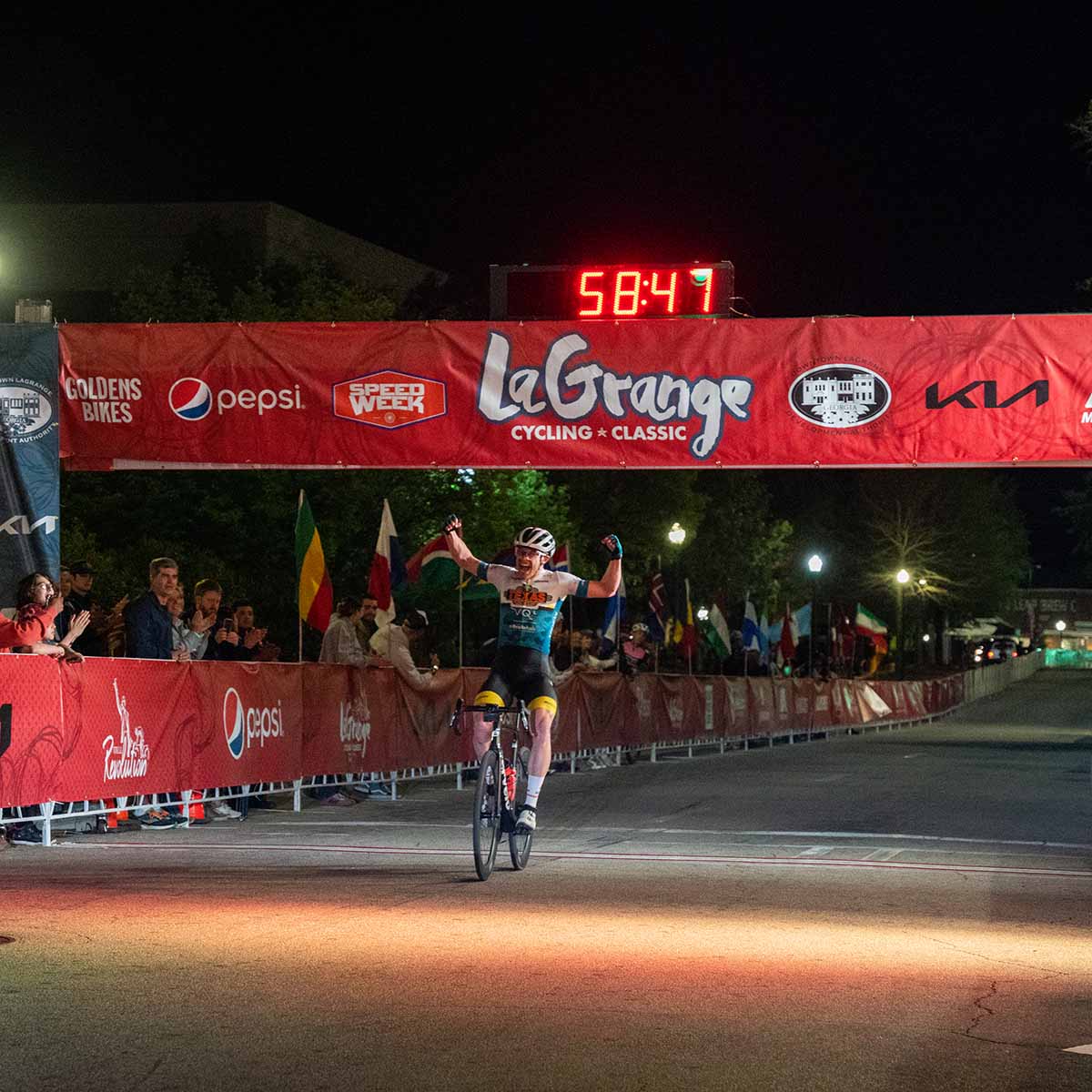
LaGrange Cycling Classic Weekend Getaway

The Ultimate West Point Lake Getaway
Visit LaGrange, Inc. 206 Ridley Avenue • LaGrange, GA 30240
706-668-5555 [email protected]
© 2023 Visit LaGrange, Inc. | All Rights Reserved | Privacy Policy
built with ♥ by Atomic Brand Energy
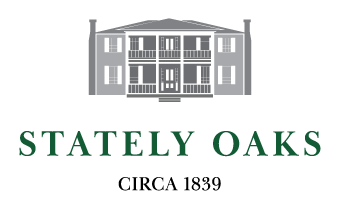
Welcome to Stately Oaks Historic Site
At the margaret mitchell memorial park.
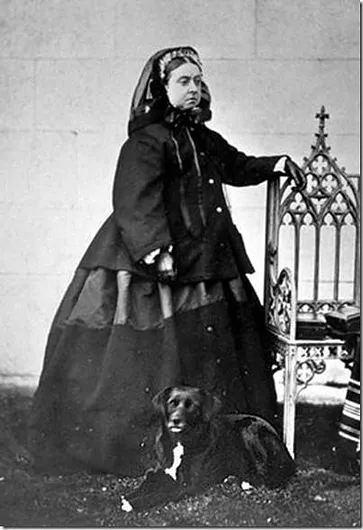
Grounds open: 12pm – 4pm House Tours: 12pm – 3pm
Last house tour at 3pm. House tours are on the hour.
Only open Friday during January
Advance ticket purchase not needed for groups of less than 20 guests.
We can also host your Meetings and Events in the Schoolhouse see rental page or call for details.
770-473-0197
100 Carriage Ln, Jonesboro, GA 30236 PO Box 922, Jonesboro, GA 30237
Fridays 12pm - 4pm
Subscribe for Updates
Only open fridays 12pm-4pm.

Upcoming Events
- Jepson Center & Telfair Children's Art Museum
- Telfair Academy
Owens-Thomas House & Slave Quarters
Built in 1819, this mansion exemplifies the neoclassical styles popular in England during the Regency period. The Owens-Thomas House & Slave Quarters allows visitors to explore the complicated relationships between the most and least powerful people in the city of Savannah in the early 19th century.
Our tours focus on the art, architecture, and history of the home through the lens of slavery. Visitors will experience an inclusive interpretation of not only the wealthy families that inhabited this home for a span of over 100 years, but of also the enslaved people who lived and labored here.
Owens-Thomas House & Slave Quarters Tours
- Guided tours are given at 15-minute intervals. The last tour begins at 4:00pm.
- Tours typically last around 45 minutes to an hour.
- Tour groups consist of up to 12 people.
- Please check in onsite to get a tour time, even if you’ve purchased tickets at our other two sites.
- Daily tours at the Owens-Thomas House & Slave Quarters fill up fast on a first-come, first-served basis.
*Due to the historic nature of the site, the Owens-Thomas House & Slave Quarters contain the original staircases of the site with no elevator access.
- Jepson Center : 7 mins
- Telfair Academy : 7 mins
History of the Richardson-Owens-Thomas House
Shipping merchant and enslaver Richard Richardson commissioned this house around 1816, and his family moved in upon its completion in 1819. The home was designed by English architect (and relative to Richardson by marriage) William Jay but was constructed by builder John Retan and likely a team of free and enslaved men in his charge. The property also included a two-sided privy and a building located on the east end of the lot, which was divided into a carriage house and slave quarters.
The Richardsons only lived in the home for a few years before they saw a steady decrease in their prosperity. After the combination of the financial Panic of 1819, a yellow fever epidemic, a fire that destroyed half the city, and the death of Frances and two of the children, Richardson decided to sell the house and move to Louisiana, where he had family and business interests.
By 1824, the Bank of the United States owned the home, which they leased to Mary Maxwell as a boarding house. The Marquis de Lafayette was a guest of Mrs. Maxwell when he visited Savannah in March 1825 as part of his whirlwind tour of the United States for the 50th anniversary of the American Revolution.
In 1830, lawyer, landholder, and enslaver George Welshman Owens purchased the property at auction for $10,000. He lived here with his wife, Sarah, their six children, and up to fourteen enslaved laborers. Over the next 121 years, the home would continue to be owned by the Owens family until the last descendent, Margaret Gray Thomas, George Owens’s granddaughter, bequeathed the property upon her death in 1951 to the Telfair Academy of Arts and Sciences to be run as a house museum in honor of her grandfather, George Owens, and her father, Dr. James Gray Thomas. The site opened to the public in 1954.
Carriage House
Orientation gallery.
The south half of this building originally housed horses and carriages on the first floor with a hay loft on the floor above.
Slave Quarters
The north half of the building contains the original slave quarters for the site. This two-story structure was composed of three rooms on each level. About five to fourteen enslaved people, most of which were female and children or teenagers, lived and worked on the site at any given time. These individuals worked in domestic labor duties like cooking, cleaning, washing laundry, and raising children.
- View image 1 in lightbox:
- View image 2 in lightbox:
- View image 3 in lightbox:
- View image 4 in lightbox:
Parterre Garden
The parterre style garden occupies the space between the main house and the carriage house. This area originally functioned as a work yard, which likely included a small kitchen garden, areas to dry laundry and clean rugs, and perhaps pens and coops for small livestock and chickens. It even contained a two-sided privy, or outhouse, in the northeast corner.
Originally, this space was a work yard. In 1956 it was transformed into an English parterre garden.
The Mansion
Public spaces.
When the Richardson or Owens families entertained, they did so in the public spaces of their home: the drawing room, front hall, and dining room. These spaces, designed in the finest Regency style and filled with American and English furniture and decorative arts, were intended to impress. They feature elaborate molding, faux finishes, curved walls, and decorative sidelights.
Entertaining spaces also allowed for transfers of information, both intentionally and circumstantially. Peter, the Owens family’s enslaved butler, doubtlessly listened closely as George Owens debated politics and policies that would affect the lives of himself and his family and friends.
Private Spaces
The bedrooms, library, and family dining room of the home were considered more private spaces utilized by the family and close friends, rather than entertaining spaces for formal events. These rooms allow for an in-depth exploration of how the economic elite and their enslaved servants interacted on a daily basis.
Second-floor bridge inside the house
The formal dining room
- View image 6 in lightbox:
- View image 7 in lightbox:
- View image 8 in lightbox:
Butler’s Pantry
Enslaved butlers managed not just the daily operations of upper-class homes, but also the enslaved staff that serviced them. In addition, enslaved butlers maintained the fine silver, china, and glassware used in entertaining. They would have stored valuable items in this space, which is complete with original cabinetry’s faux finishes, reproduced according to the results of paint analysis.
The basement, which retains many original components, contains the kitchen, scullery, a large cistern, and other workspaces. These wonderfully preserved spaces offer more interpretive text and material to help visitors understand the day-to-day lives of the enslaved people who lived and worked here.
Bathing Chamber at the Owens-Thomas House & Slave Quarters
Name Wall at the Owens-Thomas House & Slave Quarters
- Decorative Arts
The furniture and decorative objects from Telfair’s collection that are displayed at the Owens-Thomas House date largely from the early to mid-19th century. Most were produced in England or America. About one third of the objects descended in the Owens family, and many others were owned by wealthy Savannahians of the same period.
Frequently Asked Questions (FAQ)
When we open the site each day, tour slots are available for visitors on a first-come, first-serve basis. You must book a tour in-person at the ticket booth. If you would like to book a tour for later in the day, you are more than welcome to choose a later timeslot as long as we have enough available capacity for your group! We recommend showing up as early as possible if you have a large party or would like to reserve a particular tour time that day.
Unfortunately, we only reserve tour slots for the current day. However, if you have a large group consisting of 12 people or more (i.e., a Girl Scout Troop, school groups, a large family/travelling tour group, etc.), visit telfair.org/group-tours/ for more information and advanced booking options. Keeping in mind our limited capacity and staffing requirements, we request you make your reservation at least four weeks in advance.
We currently do not have an online booking system, and tours may only be booked in-person at the ticket booth. We apologize for any inconvenience!
Yes, all visitors must reserve their tour times in-person at the ticket booth. The line ensures that tour times are made available to all our visitors on a first-come, first-serve basis.
Telfair Museums only offers a three-site pass to ensure that our visitors have the opportunity to experience all the museum has to offer at one combined price.
Our interior waiting area has limited capacity, so keep in mind that we are only able to allow one group in at a time. Approximately 5-10 minutes before your tour begins, a Historical Interpreter will welcome all visitors in the tour group to spend the remainder of their waiting time in the Orientation Gallery. This space houses displays of introductory information available to read while you wait, as well as benches that visitors may rest on indoors before their tour starts.
If your waiting time is 20 minutes or more, we have additional benches in the Courtyard and Garden on the property. You are more than welcome to visit another location during your waiting time, just be sure to return 5-10 minutes prior to your tour start time
We put out the sold-out notices as soon as we reach our capacity for the day, so if you haven’t already checked in at the ticket booth to receive your tour time, we unfortunately don’t have the capacity to accommodate you today. While we’d love to allow as many visitors as possible to experience this site, we have limited visitor entries each day to help preserve the historic integrity of the buildings themselves.
Guided tours typically last somewhere between 45-60 minutes.
Due to our buildings’ capacity limits and other logistical challenges, we currently only offer guided tours through the property which begin every 15 minutes. However, the other two Telfair Museum sites do not require a tour, so if you prefer a self-paced experience, we recommend visiting the Telfair Academy and Jepson Center!
While some of us would love to accommodate all kinds of furry friends, our sites only allow service dogs required for a disability.
We have paper transcripts of the audio tour available in Spanish, so just ask a Historical Interpreter and we’ll be happy to assist you! We are currently working on developing translations in additional languages, and we appreciate your patience while we expand our language accessibility.
The Orientation Gallery and Slave Quarters have ramped entrances, but the main building is unfortunately not ADA accessible. There are several flights of stairs within the house itself, but there are benches and chairs throughout where visitors who would like to opt out may sit and wait for their group. We apologize for the inconvenience!
- Our Three Museums
- Hours & Admission
- Telfair Children’s Art Museum
- Group Tours
- School Tours
- Girl Scout Tours
- Directions & Parking
- Free Family Days
- Accessibility & Policies
- Exhibitions
- Explore All Blog Topics
- Arts in Savannah
- Art and Technology
- Contemporary Artists
- Collecting for the Museum
- Owens-Thomas House Ownership and Architecture
- Slavery in Savannah
- Mary Telfair
- Growth of Savannah
- Architecture
- Early Innovations
- The Regency Style
- Building for the City
- Youth Classes
- Adult Classes
- Summer Camp
- Adult Programs
- Family Programs
- Teen Council
- Become a Member
- Donate & Sponsor
- Director’s Circle
- Corporate Partners
- Docent Program
- Member Affinity Groups
- Member Portal
- About the Collection
- Search the Collection
- Rights & Reproductions
- Our Mission
- Outreach & Community Impact
- Board of Trustees
- Annual Report
- Event Rentals
- Job Opportunities
- Get Directions
- View Upcoming Events
Georgia's Antebellum Trail

Top ways to experience nearby attractions

Most Recent: Reviews ordered by most recent publish date in descending order.
Detailed Reviews: Reviews ordered by recency and descriptiveness of user-identified themes such as wait time, length of visit, general tips, and location information.
Also popular with travelers


Georgia's Antebellum Trail - All You Need to Know BEFORE You Go (2024)


- Latest Tips
- Australia & So. Pacific
- Latin America
- Middle East
- North America
- Scandinavia & Russia
- Adventure Vacations
- Family Vacations
- Food & Wine
- Golf & Spa
- Money Saving Travel
- Romantic Vacations
- Traveling With Pets
- Unique Vacations
- Wellness Vacations
- Write for us
10 Most Beautiful Historic Southern Plantation Homes You Can Visit
Southern charm: 10 of the most historical southern plantation homes.
With their historic architecture and stunning gardens, historical Southern plantation homes are full of old-world charm and beauty. More importantly, they have rich stories to tell because they played significant roles in our nation’s history. If experiencing the storied history and architectural beauty of a southern plantation home is in your future, then these charming historical Southern plantations should not be missed:
Pebble Hill Plantation
Located in Thomasville, Georgia, this antebellum plantation and museum was first established when Thomas Jefferson Johnson purchased the land in 1825. Johnson first raised cotton and then introduced rice, a profitable crop in Georgia during the 19th century.
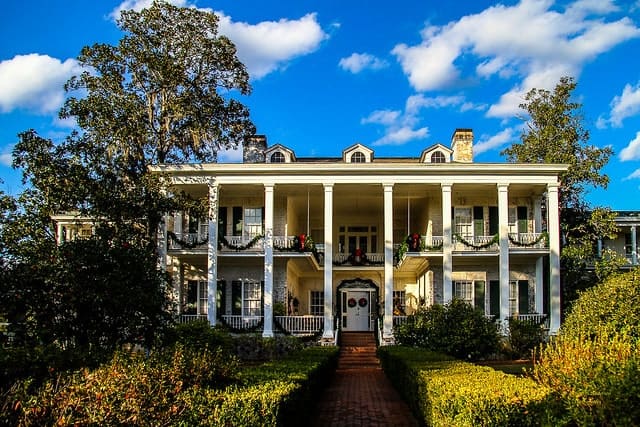
After Johnson’s death, the plantation was inherited by his daughter, Julia Ann. In 1850, a lovely plantation home was built upon the property by English architect John Wind.
Julia and her husband struggled with the property during Reconstruction in the South, and the property was purchased by Thomas Melville Hanna in 1896. After his death, Pebble Hill passed to his daughter, Kate, who turned it into a hunting estate, which were popular during the mid-1880s.
Kate’s daughter, Elisabeth, inherited the plantation after her mother’s death in 1936 and decided to turn the plantation into a museum for all to enjoy. Today, the grounds are well-maintained and feature beautiful gardens that are worth exploring.
Evergreen Plantation
If Evergreen Plantation seems familiar, you might have seen it featured in Quentin Tarantino’s 2012 film, “Django Unchained” . The stunning Greek Revival style building and plantation grounds were used as a backdrop to shoot some of the film’s scenes.
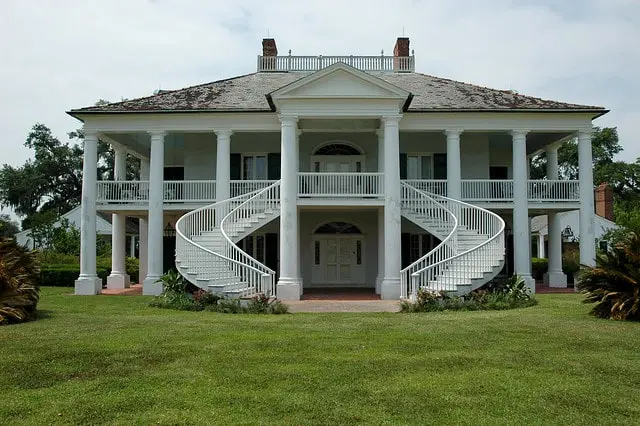
Located in Edgar, Louisiana, just outside New Orleans, the plantation is considered the most intact plantation in the South and still produces sugar cane to this day. As you explore the grounds, be sure to check out the 22 intact slave cabins, which are arranged in a double row along its oak alley.
Whitney Plantation
Whitney Plantation, located in Wallace, Louisiana, was also featured in “Django Unchained” — but this isn’t your typical historical Southern plantation. In 2014, the 2,000-acre property was converted into the first slavery museum in America.
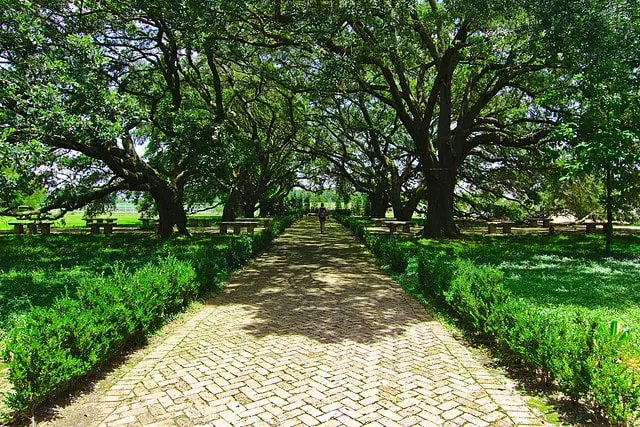
Unlike other plantations, Whitney Plantation doesn’t sugarcoat the lives of enslaved Africans who worked the former indigo and sugar farm. Jim Cummings, the owner of Whitney Plantation, has spent millions on the museum’s artifacts and restoration to give visitors a true sense of life in the antebellum South.
Shirley Plantation
Dating back to 1614, Shirley Plantation is the oldest plantation in America . Located in Charles City County, Virginia, the plantation once produced tobacco that was sent around the colonies and shipped to England.
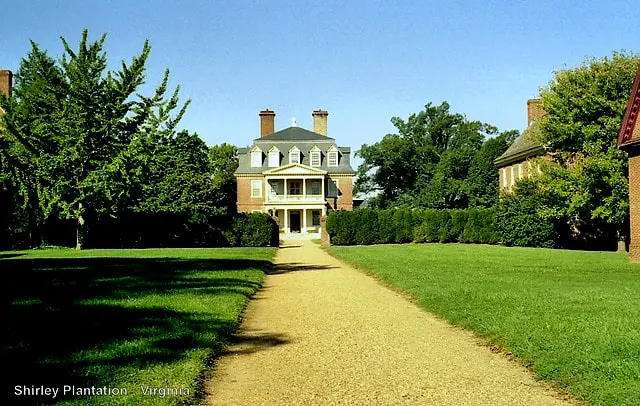
Although the land was originally settled in 1613, a portion of the land was granted to Edward Hill in 1638. Anne Hill Carter, who was born on the plantation, was the mother of Confederate General Robert E. Lee.
In fact, Hill’s direct descendants continue to own and operate the plantation to this day, making it the oldest family-owned business in North America.
Nottoway Plantation
Nottoway Plantation in White Castle, Louisiana, is home to the South’s largest antebellum mansion. The ornate, Greek and Italianate style mansion is bursting with opulence and demonstrates the vast wealth of prestigious sugarcane planter John Hampden Randolph.
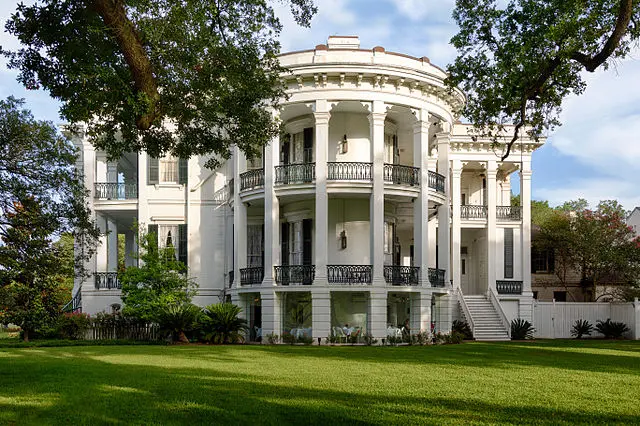
Built in 1859, the jaw-dropping mansion has three floors and a total of 64 rooms, 165 doors, 12 hand-carved Italian marble fireplaces and 200 windows. The spectacular home is listed on the National Register of Historic Places and is now a resort destination.
Belle Meade Plantation
Located in Belle Meade, Tennessee, the Belle Meade Plantation is a beautiful Greek Revival mansion that now operates as a museum. The land was originally purchased by John Harding in 1806 and used to produce cotton.
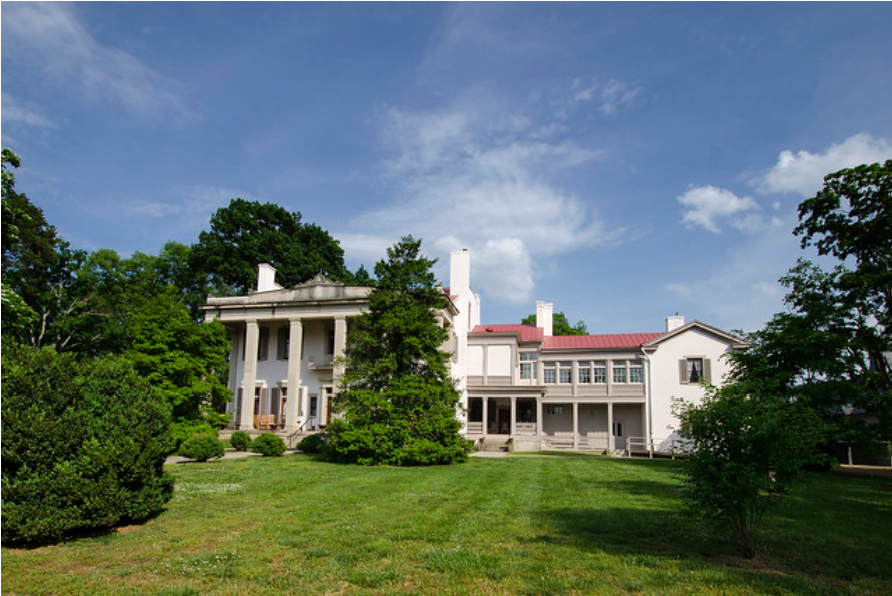
Harding quickly became one of the largest slave holders in the Nashville area. With his new fortune, he built a brick house on a small hill, which he called “Belle Meadow.”
What started as a 250-acre property would become a 5,300-acre farm that raised thoroughbred horses. The farm survived the Civil War and was passed down through generations of the Harding family until they ran into serious debt in 1893. The plantation was sold in 1906 and was converted into an educational non-profit organization in 1953.
Magnolia Plantation
Founded in 1676 by Thomas Drayton, Magnolia Plantation and Gardens is renowned for its beautiful gardens and rich history. Located along the banks of the Ashley River near Historic Charleston, S.C., the 464-acre property has survived natural disasters, as well as both the American Revolution and Civil War.
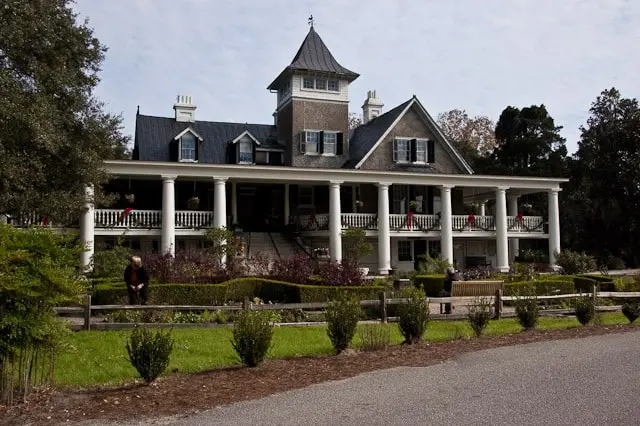
There is much to see and do at Magnolia, so be sure to carve out a couple hours to walk through all the gardens, take a tour of the magnificent plantation home and let the kids enjoy the petting zoo.
If you’re visiting the wonderful city of Charleston, you can’t miss Boone Hall. Located across the Cooper River in Mount Pleasant, S.C., Boone Hall is America’s oldest working plantation and the most photographed in the country.
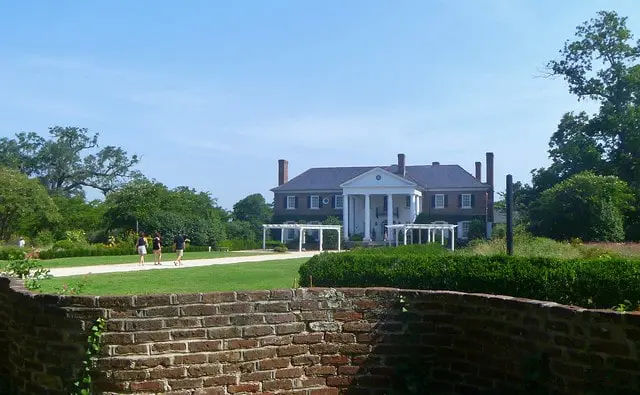
People from across the world come to Boone Hall to see its famous Avenue of Oaks, explore the working plantation and Georgian-style home and experience the only live presentation of Gullah culture at The Gullah Theater. Educational and awe-inspiring, it’s easy to see why this historical Southern plantation draws thousands of visitors each year.
Destrehan Plantation
Established in 1787, Destrehan Plantation was originally a thriving indigo plantation and sugarcane farm. Situated 25 miles from New Orleans, this antebellum mansion is noted for its French Colonial style architecture, which was later modified with Greek Revival style elements.
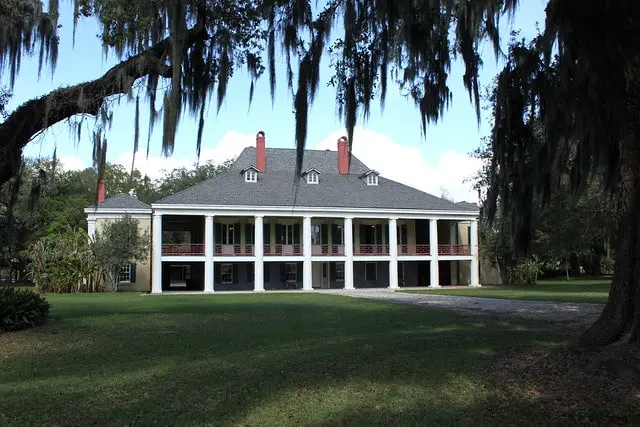
Destrehan Plantation has a fascinating history that starts with the plantation’s second owner, Jean-Noel Destrehan, who was deeply involved in the state’s politics, serving on the Orleans Territorial Council and as a U.S. senator until he resigned after a month.
Destrehan paved the way for the Creole system of slave labor, in which head slaves were appointed to oversee tasks on sugarcane plantations. Although the history is dark, the plantation’s costumed historical interpreters do an excellent job of telling the rich stories of the Destrehan family and the slaves who worked there.
Belle Grove Plantation
A trip to Belle Grove Plantation gives visitors the opportunity to venture into the past and see what life was like for early settlers in Shenandoah Valley. Located near Middletown, Virginia, the 1797 antebellum plantation is still farmed today and features a large limestone manor house in Federal style architecture.
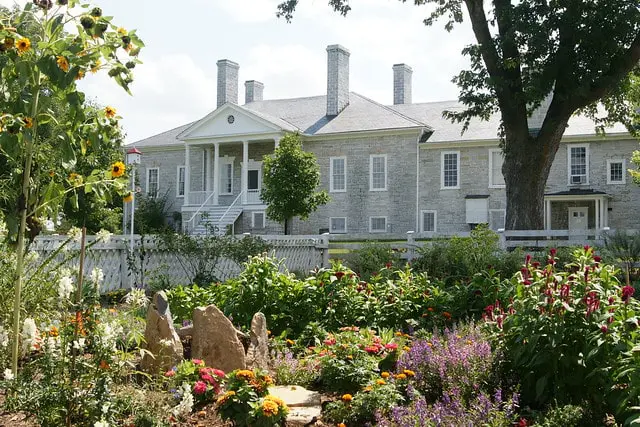
The impressive manor was built by Major Isaac Hite and his wife, Nelly Madison Hite, the sister of President James Madison. The home was originally named after Nelly’s grandmother’s home in Port Conway, Virginia, which is the site where James Madison was born.
Now a historic house museum, visitors can tour the large manor, an 1815 icehouse and smokehouse, a slave cemetery and a heritage apple orchard — all set against a stunning mountain backdrop.
Full of History and Charm
Before the outbreak of the Civil War, there were more than 500,000 plantations and farms in the South. Although many did not survive reconstruction, those Southern plantation homes that have remained well-preserved now offer an invaluable glimpse into our country’s storied past.
*************************************** About The Author: Traci Magnus was raised on the Charleston Coast and attended the College of Charleston before moving to New York City in the mid 1990s. Her first job in the Big Apple was with the renowned NYC real estate brokerage Douglas Elliman. For the next decade, she honed her marketing skills at some of Madison Avenue’s top advertising agencies. In 2006, she returned to Charleston along with her husband Glenn and their son Max. She joined the Dunes Properties team in early 2008 as Director of Marketing. ***************************************
Share This Story, Choose Your Platform!
Related posts.

Travel Inspirations For Restoring Your Wanderlust

First-Timer’s Guide to Visiting Antarctica – Helpful Tips

Top Must-Visit Sightseeing Locations Landmarks and Attractions in Cape Town

Choosing the Best Honeymoon Resort in the Maldives
Our latest travel tips, tricks and hacks are here to help you navigate the world. Whether you’re looking for a romantic vacation, traveling with kids, a solo adventurer, or looking for unique travel experiences, great suggestions are just a quick search away!
Contact us by email at [email protected]
© Copyright 2008 - 2024 | All Rights Reserved | Website designed by Beverley Designs | Privacy Policy | Terms & Conditions
Wicked Good Travel Tips is committed to ensuring digital accessibility for people with disabilities. We are continually improving the user experience for everyone, and applying the relevant accessibility standards. We welcome your feedback on the accessibility of the website. Please let us know if you encounter accessibility barriers here by emailing us at [email protected] . We will try to respond to feedback within 5 business days.
This site uses cookies. Opt out at any time. More details
Home › Things To Do › Historic Houses
Savannah Historic Homes & House Tours

Savannah has an unusually large number and variety of historic house museums for a city of its size. Most of them date from the early to mid 19th century and are restored to reflect that period.
Savannah’s historic homes can offer a closer look at the lives of its (mostly white and wealthy) residents in times past, an appreciation of the architecture and furnishings of a particular period, or even just something to do on a rainy day.
In the majority of these houses, guided tours only are available, though the gardens (where applicable) can be toured at your own pace. Allow about an hour or so for your visit to any of the homes.
See also: – Savannah’s must-see sights – Savannah’s events by month: January, February, March, April, May, June, July, August, September, October, November, December – More attractions and things to do – Museums in Savannah – River Street
Andrew Low House
329 Abercorn Street. Official website
The Andrew Low House was built for one of Savannah’s wealthiest businessmen, the Scottish-born cotton factor Andrew Low. It was built in 1848-1849, the architect believed to be John S Norris.
The house is also associated with Juliette Gordon Low and the Girl Scouts story: Gordon Low lived here after her marriage to Andrew Low’s son William Mackay Low. Though they later divorced, Gordon Low remained in the house until her death; the adjacent carriage house served as the first meeting place for the Girl Scouts organization, which she founded in 1912.
The house (today owned by the Colonial Dames of Georgia) has numerous restored rooms showing how life would have been for a wealthy Savannah family in the 19th century, including a children’s playroom and, more unusually, one of the earliest indoor bathrooms.
The Andrew Low House also has one of the few surviving original gardens created in 19th-century Savannah. The design of the gardens dates from the mid century, shortly after the completion of the house.
→ See current hours and admission for the Andrew Low House
Davenport House
324 East State Street. Official website
The Davenport House Museum is one of the oldest of Savannah’s historic houses open to the public. It is also significant as one of the first major successes of the historic preservation movement in Savannah.
New England builder and architect Isaiah Davenport built this house for his family from around 1820, completing it a year or so later. A large and distinctive red brick structure, it is designed in the Federal style, popular from the last decades of the 18th century.
The Historic Savannah Foundation saved the house from destruction in the mid 20th century. Once serving as their headquarters, it opened as a museum in 1963. The house is restored to its appearance in the 1820s; the gardens have also been redeveloped.
Tours explore the life and household management of a thriving Savannah family in that period, and outline the strategies and achievements of the projects undertaken in Savannah over the past several decades to preserve the city’s historic heritage.
The Davenport House also offers several annual special events, some seasonal and others focusing on aspects of Savannah’s history and preservation. See upcoming events
→ See current hours and admission for the Davenport House Museum
Flannery O’Connor Childhood Home
207 East Charlton Street. Official website
This house is the former residence of Flannery O’Connor, one of the South’s most celebrated authors. O’Connor’s literary reputation rests on her four works – two novels, Wise Blood and The Violent Bear It Away , and two collections of short stories, A Good Man Is Hard To Find and Everything That Rises Must Converge , the latter published posthumously – bizarre and highly religiously-inflected works that drew upon her intense and lifelong engagement with Catholicism.
O’Connor lived in the house until the age of 13 (a third of her short life), after which her family moved to Atlanta. After traveling north for her education, O’Connor spent much of her remaining time on her mother’s Milledgeville, GA farm. She died aged 39, of lupus.
The Flannery O’Connor childhood home is one of Savannah’s more unique historic house museums. It is the only house museum that depicts life as it would have been during the Great Depression of the early 20th century. It also provides an insight into life for a more modest middle class family, in contrast to the homes of Savannah’s elite.
→ See current hours for the Flannery O’Connor Childhood Home
Green-Meldrim House
14 West Macon Street. Official website
Amongst Savannah’s most popular historic houses is the Green-Meldrim House, on the west side of Madison Square. From this house, General William Sherman wrote his historic telegram presenting the City of Savannah to President Lincoln as a “Christmas present.” It is currently owned by the adjacent St John’s Episcopal Church.
The house was built for English merchant and one of the wealthiest businessman in Savannah, Charles Green, in the early 1850s, at that time one of the grandest houses in the city and reputedly, the single most expensive ever built to that date. It was designed by John S Norris, and is considered an excellent example of Gothic Revival architecture.
Charles Green famously offered the use of his house to General Sherman during the Union army’s occupation of Savannah around the winter of 1864. Some said this was a gesture intended to spare his southern fellow-citizens the indignity of hosting the enemy. Others thought Green was motivated by the hope that the invading forces would not burn his fine new house, though he needn’t have worried: Sherman spared Savannah.
→ See current hours and admission for the Green-Meldrim House
Harper-Fowlkes House
230 Barnard Street. Official website
The Harper-Fowlkes House, a striking Greek Revival home on Savannah’s Orleans Square, was once owned by the influential Champion and McAlpin families. It stands today as testament to the preservation work of Alida Harper-Fowlkes.
The house was designed by Charles Cluskey in the Greek Revival style, constructed in 1842. The Harper-Fowlkes House is the last remaining of the large homes that once graced the formerly-fashionable Orleans Square, its imposing double-story columns a hint of the square’s lost grandeur.
The Harper-Fowlkes House was owned by various members of the Champion and McAlpin familes for much of its first century. Alida Harper (Alida Harper-Fowlkes after her marriage) bought the property in 1939. Though she was never very active in Savannah’s leading preservationist organization, the Historic Savannah Foundation, Harper became an influential force in the restoration of Savannah’s old houses and neighborhoods.
Harper substantially restored the historic Orleans Square home, later deeding it to the Society of the Cincinnati with the proviso that it would never be sold (the house is currently managed by the Coastal Heritage Society). Tours discuss the home’s architecture, artworks and antiques and Harper’s own preservation work.
→ See current hours and admission for the Harper-Fowlkes House
Juliette Gordon Low Birthplace
10 East Oglethorpe Avenue. Official website
Juliette Gordon Low is known nationwide as the founder of the Girl Scouts of the USA. The Birthplace, or Wayne-Gordon House as it is otherwise called, was her childhood home. It is one of Savannah’s key cultural sites.
Juliette Magill Gordon was born in 1860. The house, built around 1820 for the recent mayor of Savannah and later Supreme Court Justice James Moore Wayne, was bought from him by her grandfather, politician and railroad man William Washington Gordon I. Its design is attributed to William Jay.
Juliette Gordon Low (as she became known after her marriage to William Mackay Low in the 1880s) founded the Girl Scouts in 1912, inspired by the Boy Scouting/Girl Guiding organizations she had learned of during her travels in Britain.
The Juliette Gordon Low Birthplace is both a museum of the Girl Scouts organization and a historic home. It is restored to reflect the life of an upper class southern family in the late 19th century, also displaying many artifacts from Low’s life and the history of Girl Scouting.
→ See current hours and admission for the Juliette Gordon Low Birthplace
King-Tisdell Cottage
514 East Huntington Street. Official website
The King-Tisdell Cottage is a rare example of a visitable Savannah historic home formerly owned by and depicting the lives of the city’s African-American citizens.
The house was originally built in 1896 for the white woodmill owner WW Aimar, constructed in the delightful ‘gingerbread’ style then popular. The King-Tisdell Cottage is a beautiful example of this late-19th century architectural trend, characterized by the intricate, ornate woodword employed as decoration of the porches and other outer features of a dwelling.
In 1925, the house was bought by a young African-American couple, Eugene and Sarah King, both of them representative of the Black entrepreneurship that often thrived in early 20th-century Savannah. Eugene King was the owner of a laundry business; Sarah King would operate her own confectionery out of their home, then located at 516 Ott Street, out in Savannah’s southern addition.
More of a museum in a historic house than a historic house museum, its exhibits include: the experiences of enslavement and emancipation and of Black entrepreneurship in the city; the Gullah-Geechee culture of the sea islands and coast; the life of museum founder and Civil Rights activist WW Law; and the stories of the home’s former owners.
→ See current hours and admission for the King-Tisdell Cottage
Mercer-Williams House
429 Bull Street. Official website
The Mercer-Williams House, former residence of the preservationist and antiques dealer Jim Williams, is undoubtedly the most widely-known of Savannah’s historic homes.
The early history of the house was largely unremarkable. John S Norris designed the home in 1860, for Hugh Weedon Mercer. War interfered with its construction, however, and it was not completed until 1868, by which time Mercer had sold it to John Wilder.
In 1969, Williams bought the house, restoring the property and redesigning the interiors according to his own tastes and interests.
Always a controversial figure, Jim Williams became a notorious one when he shot and killed his lover in the old Mercer House. Soon after, the man, the events and the home would all be immortalized in John Berendt’s international best-seller, Midnight in the Garden of Good and Evil , also made into a movie.
Tours of the Mercer-Williams House focus on the architecture and restoration of the house; Williams’s legacy as a historical preservationist; and the remaining antiques (most of the antiques with which Williams filled the house have now been sold). Discussion of both the shooting and “The Book” is minimal.
→ See current hours and admission for the Mercer-Williams House
Owens-Thomas House & Slave Quarters
124 Abercorn Street. Official website
The Owens-Thomas House & Slave Quarters is one of Savannah’s most outstanding antebellum houses, and also one of its most completely preserved. Enslaved people’s quarters and English-style parterre gardens can be seen, besides the architecture and antiques of the main house itself.
The Owens-Thomas House dates from the 1810s, built for wealthy cotton merchant and banker Richard Richardson and his family. It was William Jay’s first Savannah commission: Jay is one of the most notable architects to have worked in the city, and the Owens-Thomas House is considered his finest work.
The house was completed in 1819, but tragedy soon struck. By 1822, Richardson’s wife Frances and two of their children were dead, and Richardson had lost their home, ruined by a recession and bad investments.
→ See current hours and admission for the Owens-Thomas House & Slave Quarters
Savannah House Tours & Garden Tours
Several annual tours of private houses, gardens and other architecturally distinguished buildings, many of which are not usually open to the public, are conducted in Savannah.
In spring are the Savannah Tour of Homes and Gardens (recently suspended on account of the pandemic) and the North of Gaston Street Tour of Hidden Gardens .
Other home tours in Savannah and nearby include the winter Holiday Tour of Homes and Inns , and prior to the pandemic the Tybee Island Tour of Homes and the St Vincent’s Academy Fall Tour of Homes.
More Things To Do In Savannah & Nearby
– Guided tours of Savannah – Black history sites in Savannah – Kayak tours near Savannah – Boat tours from Savannah and nearby – Savannah museums – Beaches near Savannah – Art galleries in Savannah – Savannah events – Georgia food festivals – Hilton Head Island events – Ossabaw Island tours – Sapelo Island tours
© Melanie K Jones 2024

Washington-Wilkes, Georgia
Spring tour of homes & art show 04.06.2024.
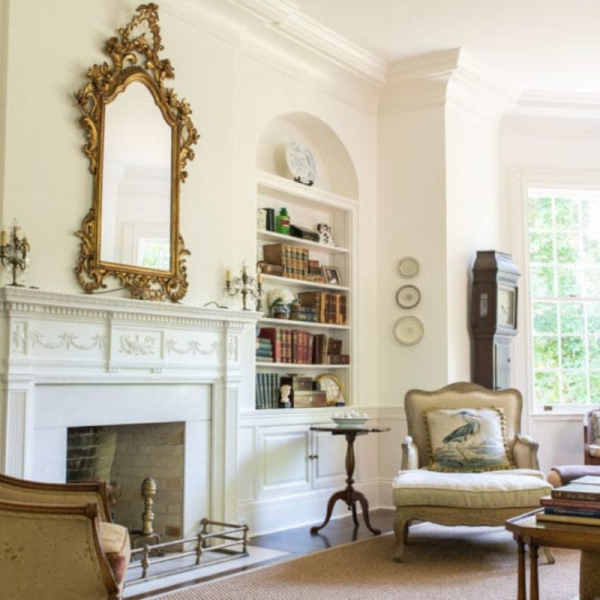
Homes on Tour
Get an intimate look inside a selection of seven extraordinary, privately owned homes. Explore the rich architecture of these historic buildings and the savory stories that have filled their walls and kept this community talking for more than two centuries.
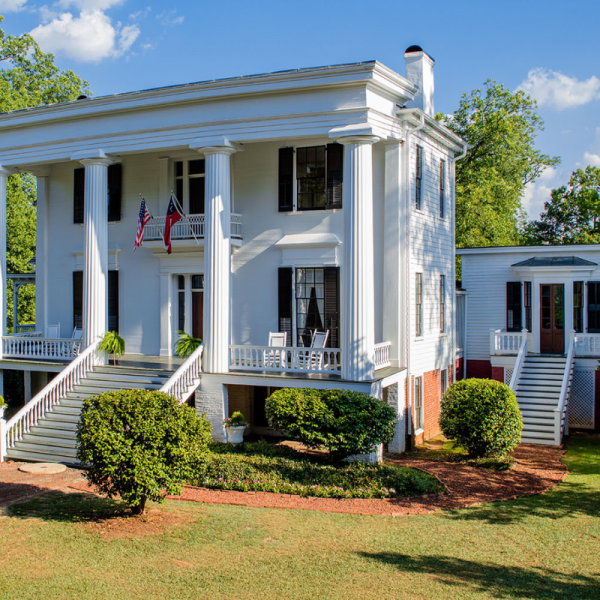
Local Attractions
Discover 250 years of American heritage in Georgia’s finest house museums, battle sites, library and churches. These and other notable attractions tell the story of this small town with big history, one filled with legendary feats, prominent families and innovative discoveries.
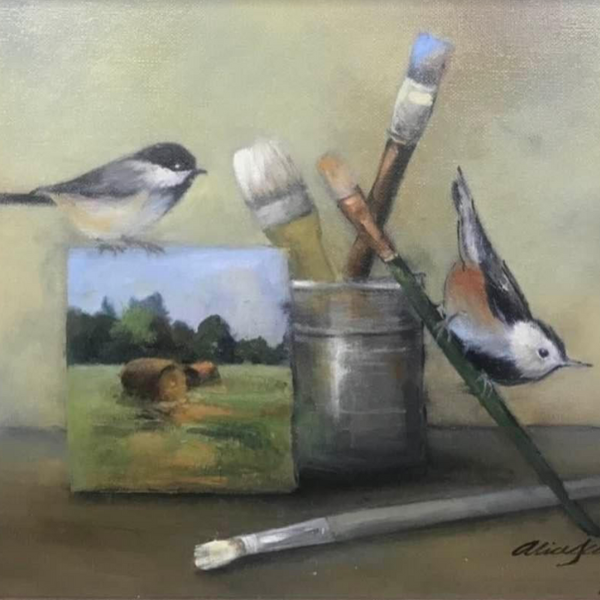
Stroll and shop the art show, showcasing fine art, handcrafted jewelry, unique pottery and art photography, carefully curated for endless options of beautiful, original work from invited artisans throughout Georgia, selected for their originality, ingenuity and excellence.
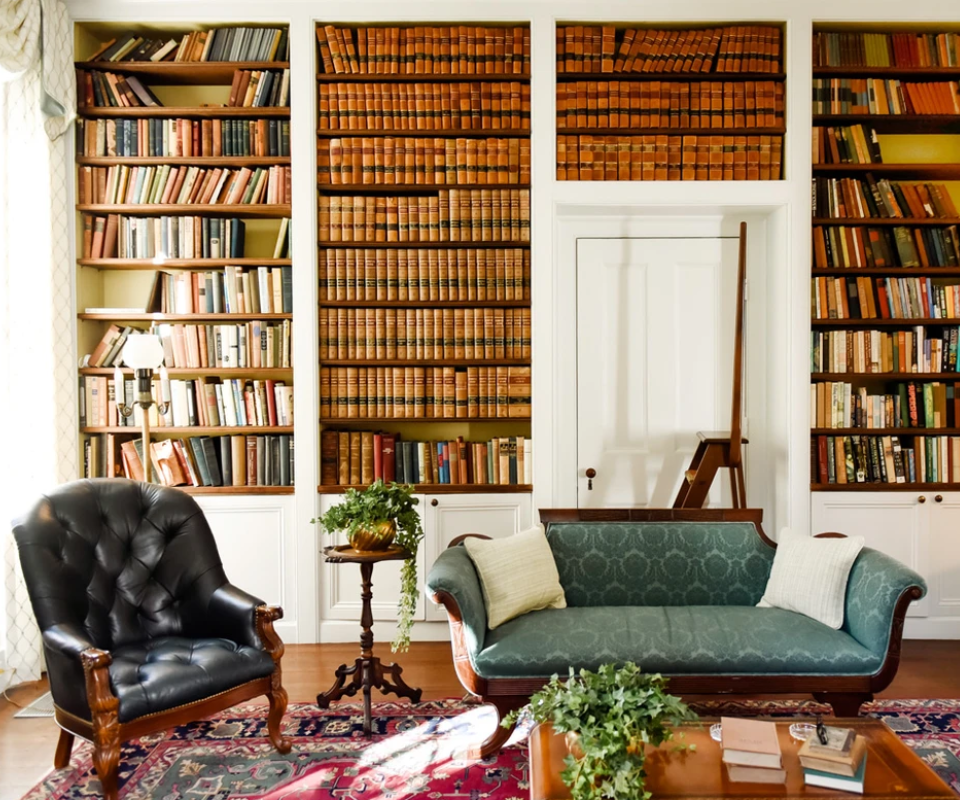
Washington, georgia
Timeless beauty.
Named by Southern Living Magazine as one of the “Prettiest Small Towns in Georgia,” Washington boasts more antebellum homes per capita than any other town in America. We invite you to step into southern antiquity as you stroll our tree lined sidewalks during our 2024 Spring Tour of Homes and Art Show. A true Southern delight, Washington is the perfect place to spend a day. Or a weekend. Or a lifetime.
What Visitors Say About Our Town
Online Ticket Sales Have Concluded, But Tour, Attraction & Luncheon Tickets Can Be Purchased at Tour HQ the Day of the Tour. Dismiss
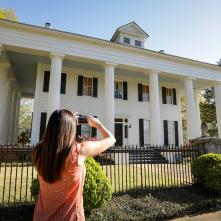
Make the most of your visit discovering Milledgeville. Take a guided tour to learn our history-filled stories or explore a trail of your own.
Your 5K Step Guide to Milledgeville
Top things to do in milledgeville this spring, 5 flannery o'connor sites of interest, six sites celebrating african-american contributions, georgia’s must visit small town, christmas at the mansion, discover more of milly.
Take advantage of the warmer days this season and see the essentials of downtown Milledgeville while getting your steps in for the day. This...
Springtime in Milledgeville, Georgia is a breath of fresh air, quite literally! As the flowers bloom and the temperatures rise, this...
Tucked between Atlanta and Savannah, Milledgeville has a rich history, breathtaking natural scenery, and Southern hospitality that will have...
What to do in Milledgeville this Fall
Milledgeville, with its stunning architecture, charming downtown district and abundant recreation, is a must-see any time of the year, but...
Spring Ramble
Georgia’s premier tour of historic homes, sites, and so much more!
Athens and Watkinsville April 19-21, 2024
View Registration Options
Explore historic private homes and sites in Athens and Watkinsville
Join us this spring in Athens, where Ramblers will enjoy the rare opportunity to explore the Classic City’s most historic homes and sites. Ramblers will also visit nearby Watkinsville and Oconee County, a first for the Georgia Trust.
Named the “South’s Best College Town” by Southern Living magazine, Athens is the beloved home of the University of Georgia and a legendary music scene. Athens boasts sixteen historic districts, each with a unique character offering a glimpse into the city’s vibrant past. Wander through streets lined with beautifully preserved architecture and rich history and explore the historic landmarks that have shaped Athens into the eclectic city that it is today.
Conclude the weekend in nearby Watkinsville, nestled in the scenic landscapes of Oconee County. Explore historic homes and farmsteads that reflect the area’s rich history.
Tickets that include meals are SOLD OUT. However, tickets for “Tour Only” (no meals included) will be available until April 17th. Walk-up tickets will not be available during the event. Tickets must be purchased in advance.
View Itinerary & Sneak Peek
Heritage Reception
A Complimentary Event for Upper-Level Georgia Trust Members ($300+) Saturday, April 20, 2024
During the Ramble weekend, before Saturday’s dinner, upper-level Georgia Trust members ($300 and up) will enjoy an exclusive private reception at Athens’ only National Historic Landmark, the 1840s Taylor-Grady House. The restored interior is adorned with antique furnishings and historically accurate paint colors. Guests will also enjoy seeing an interpretive boxwood garden. As of 2023, a new chapter is beginning for the Taylor-Grady House and will now be known as Landmark Commons, which will include not only the Taylor-Grady House, but also gardens, original out kitchen, and summer dining room. Landmark Commons aims for inclusive history through education, preservation, and hospitality.
To upgrade your membership to be a part of this exclusive reception, contact 404-885-7818 or [email protected] .
Friday, April 19 TOWN & GOWN
Named the “South’s Best College Town” by Southern Living magazine, Athens is the beloved home of the University of Georgia. Stroll through the landmark Arch onto the original campus of the nation’s first state-chartered university to see an extraordinary mix of 19th and early 20th century architecture. Take a rare look inside the University of Georgia President’s House, one of the oldest buildings in Athens and the official residence of UGA presidents since 1949.
Visit magnificent private residences in Athens’ historic Five Points neighborhood including the stunning home and gardens of the late UGA football legend Vince Dooley and his wife Barbara . See the Dearing-Wilkins House, which has been lovingly cared for by the University’s Alpha Pi sorority. Explore awe-inspiring homes in the Henderson Historic District featuring excellent examples of Folk Victorian, Queen Anne, and early 20th century Craftsman style design. Step inside the house once owned by Young Harris, who is best known as the early benefactor of Young Harris College, after whom the school was named. Return to UGA’s North Campus to enjoy cocktails and dinner at Herty Field, UGA’s first athletic field and site of the first intercollegiate football game in 1892.
Saturday, April 20 EXQUISITE HOMES
Ramble through the historic residential neighborhoods, each with their own unique character, that feature beautifully preserved architecture and historic landmarks. Explore the Cobbham Historic District , considered to be Athens’ first suburb. The neighborhood is known for its well-preserved Victorian and Neoclassical homes. See beautifully maintained residences including the Gordon-Hanks House, the Jester-Downs House, and the Thurmond-Banks-Knowlton House. Don’t miss seeing the home and gardens of the late landscape architecture professor John Linley, which were featured in Garden and Gun magazine. Discover hidden gems in the eclectic neighborhood of Pulaski Heights . Ramblers will also have exclusive access to The Hill, an enclave of historic homes that narrowly escaped demolition. These houses, now situated on a new site, are now home to renowned Southern caterer, Lee Epting. Conclude the day with cocktails and dinner on the grounds of Athens’ only National Historic Landmark, the 1840s Taylor-Grady House.
Sunday, April 21 WATKINSVILLE
Conclude the weekend in nearby Watkinsville , nestled in the scenic landscapes of Oconee County. Enjoy brunch in Bishop at Oak Hall located on the property of Hedgerow Farm, a historic farm that includes a century-old farmhouse and an early settler’s house. Wander the quaint streets of Watkinsville, the county seat of Oconee County, and explore the South Main Historic District, lined with restored historic homes and buildings.
Packet Pickup Information
Registrants can pick up their tour packets at the following times and locations. Inside your packet, you’ll receive a name badge (which serves as your ticket inside homes, sites and meal venues), detailed event program and maps. Walk-up tickets will not be available at the event. All tickets must be purchased in advance.
Event is held rain or shine.
There will be NO early packet pick-up at Rhodes Hall. Rhodes Hall will be closed for a private event on Thursday, April 18.
FRIDAY, APRIL 19 10 a.m. to 2 p.m. Lyndon House Arts Center 211 Hoyt St, Athens, GA 30601
SATURDAY, APRIL 20 8 a.m. to 2 p.m. First Christian Church of Athens 268 W. Dougherty St, Athens, GA 30601 *For those who registered for tickets with meals, breakfast will be served until 10 a.m.
SUNDAY, APRIL 21 9 a.m. to 11 a.m. Oak Hall at Hedgerow Farm 4721 Price Mill Rd, Bishop, GA 30621 *For those who registered for tickets with meals, brunch will be served until 11 a.m.
Know Before You Go
Weather/Dress Temperatures for the weekend should range from the high 70s to mid-80s during the day and low 60s at night. There is a slight chance of rain on Saturday and Sunday, so please bring a raincoat or umbrella. Please dress comfortably and wear walking footwear since many sidewalks along tour sites may be uneven. Men are not required to wear jackets to meals. Flat shoes are highly recommended.
** Please wear your name badge during meals and tour hours**
Ramble Tips
- Please wear your name badge throughout the weekend. This serves as your entry into all Ramble sites and meal venues.
- Street parking is available throughout the weekend. Many of the Ramble sites are in residential neighborhoods, so please be respectful when parking and do not block driveways.
- For Ramble sites located in downtown Athens, please be aware that there may be a fee for parking. Parking fees vary by parking garage or meter.
- SCRAMBLE YOUR RAMBLE – to control crowding, we encourage attendees to follow the program out of order.
- If you have registered for tickets with meals, Saturday’s lunch will be a boxed lunch pick-up. Grab a lunch to go and continue Rambling! For those who would like to take a break from Rambling, seating is available inside First Christian Church.
- Please refer to the “Additional Directions” sheet in your registration packet for sites not listed on the map. GPS works for most sites.
- Event occurs rain or shine.
Accommodations
The Georgia Trust Spring Ramble Athens, Georgia April 19-21, 2024
Please make your reservations right away and remember to mention you are with The Georgia Trust to get these rates. Prices do not include taxes.
Best Western Athens 170 N. Milledge, Athens 706-546-7959 $159/$169 + tax per night Reservation Cut-Off Date: March 18, 2024 Booking link
Graduate Athens 295 E. Dougherty Street, Athens 706-549-7020 $169 + tax per night Mention Spring Ramble 2024 for the discounted room rate. Reservation Cut Off Date: March 21, 2024 Booking link
Hampton Inn Athens 2220 W. Broad Street, Athens 706-548-9600 $179 + tax per night Reservation Cut Off Date: March 21, 2024 Booking link
Holiday Inn Express Athens 513 W. Broad Street, Athens 706-546-8122 $164 + tax per night Booking link
Homewood Suites by Hilton Athens Downtown University Area 750 E. Broad Street, Athens 706-548-3500 $159 + tax per night Booking link
Our Partners
Our presenting sponsors, nedra johnson, our generous sponsors, brian brodrick, what are rambles.
Rambles feature exclusive tours and social events in historic properties not usually open to the public. Tours of historic homes and buildings are self-guided, and guests provide their own transportation. Maps and programs are provided at packet pick-up. Catered meals are offered as part of registration packages; however, there are tour-only (no meals) options as well.
These trips attract hundreds of participants per Ramble and are offered two weekends each year (fall and spring). Recent Rambles have included Augusta, Thomasville, Macon and Newnan.
For more information, contact the Trust’s Special Events Department at 404-885-7812 or [email protected] .
**Sites and times are subject to change. Event occurs rain or shine.
Reuse. Reinvest. Revitalize.
Pin it on pinterest.
Lights on Macon’s historic home tours are designed with everyone in mind, regardless of age, experience, or architectural knowledge. All the information and historical background you need, plus information about the architecture of each home, is right on the website; just click on each home to view. Also, we designed the tour to be totally flexible: you can choose to walk or drive; routes can be set for as short or as long of a tour as you want. You aren’t limited in how much you can enjoy our historic homes-- spend all day if you want!
We can help you design the right tour for you or your group’s needs; see the filters above and the map/direction links to set up a tour that suits you best. If you want the guesswork taken out for you, check out the curated tour listed above, featuring the iconic Hay House and Magnolia Street homes. You can always send us a message if you need a recommendation as well; our knowledgeable and friendly staff will be happy to point you in the right direction.
Got any questions about the tour or any of the beautiful historic homes you saw? Visit our FAQ page or get in touch with us. Finally, visit our History page to learn more about the history of the city of Macon, and a bit about the tour itself.
We’re confident you will love Lights on Macon’s illuminated walking tour. Come discover the beauties of Victorian and antebellum architecture in historic Macon today, and create memories of a lifetime.

Design your tour.
Start by selecting one or more filters from the Your options list below. Your route will automatically update based on your selections.
When you’re ready to start your tour, press the first item under Your route to view more information about that destination (including walking directions).
Looking for a curated tour instead? Check out our Hay House and Magnolia Tour .
Or search by house number:
- 1. --> 934 Georgia Avenue Info
- 2. --> 964 Georgia Avenue Info
- 3. --> 1074 Georgia Avenue Info
- 4. --> 1085 Georgia Avenue Info
- 5. --> 1144 Georgia Avenue Info
- 6. --> 1183 Georgia Avenue Info
- 7. --> 397 College Street Info
- 8. --> 381 College Street Info
- 9. --> 373 College Street Info
- 10. --> 315 College Street Info
- 11. --> 348 College Street Info
- 12. --> 340 College Street Info
- 13. --> 334 College Street Info
- 14 A. --> 312 College Street Info
- 14. --> 331 College Street Info
- 15 A. --> 306 College Street Info
- 15. --> 303 College Street Info
- 16. --> 285 College Street Info
- 17. --> 275 College Street Info
- 17 A. --> 261 College Street Info
- 18. --> 294 College Street Info
- 19. --> 264 College Street Info
- 20. --> 245 College Street Info
- 21. --> 244 College Street Info
- 22 A. --> 1116 Bond Street Info
- 22. --> 260 Orange Street Info
- 23. --> 1081 Bond Street Info
- 24. --> 1087 Bond Street Info
- 25. --> 1069 Bond Street Info
- 26 A. --> 1019 Bond Street Info
- 26. --> Bond Street Info
- 27. --> 988 Bond Street Info
- 27 A. --> 1013 Bond Street Info
- 28. --> 1025 Bond Street Info
- 29. --> 1105 Bond Street Info
- 29 A. --> 1125 Bond Street Info
- 30. --> 276 College Street Info
- 30 A. --> 1167 Bond Street Info
- 31. --> 535 College Street Info
- 32. --> 547 College Street Info
- 33 A. --> 575 College Street Info
- 33. --> 562 College Street Info
- 34. --> 578 College Street Info
- 35. --> 589 College Street Info
- 36. --> 596 College Street Info
- 37. --> 618 College Street Info
- 38. --> 619 College Street Info
- 39. --> 626 College Street Info
- 40. --> 644 College Street Info
- 41. --> 647-675 College Street Info
- 42. --> 718 College Street Info
- 43. --> 730 College Street Info
- 46. --> 753 College Street Info
- 47. --> 756 College Street Info
- 48. --> 781 College Street Info
- 49. --> 811 College Street Info
- 50. --> 855 College Street Info
- 51. --> 885 College Street Info
- 52. --> 1001 College Street Info
- 53. --> 1005 College Street Info
- 54. --> 1021 College Street Info
- 55. --> 1095 College Street Info
- 56. --> 1270 Ash Street Info
- 57 A. --> 468 Orange Street Info
- 57. --> 1180 Washington Avenue Info
- 58. --> 586 Orange Street Lane Info
- 59. --> 619 Orange Street Info
- 60. --> 630 Orange Street Lane Info
- 61. --> 642 Orange Street Lane Info
- 62. --> 643 Orange Street Info
- 63. --> 902 High Street Info
- 64. --> 910 High Street Info
- 65. --> 920 High Street Info
- 66. --> 923 High Street Info
- 67. --> 935 High Street Info
- 68. --> 938 High Street Info
- 69. --> 962 High Street Info
- 70 A. --> 996 High Street Info
- 70. --> 971 High Street Info
- 71. --> 1017 High Street Info
- 72. --> 1085 High Street Info
- 73. --> 964 Magnolia Street Info
- 74. --> 972 Magnolia Street Info
- 75. --> 994 Magnolia Street Info
- 76. --> 1006 Magnolia Street Info
- 77. --> 1015 Magnolia Street Info
- 78. --> 1030 Magnolia Street Info
- 79. --> 1031 Magnolia Street Info
- 80 A. --> 1042 Magnolia Street Info
- 80. --> 1039 Magnolia Street Info
- 81. --> 1047 Magnolia Street Info
- 82. --> 1052 Magnolia Street Info
- 83. --> 1055 Magnolia Street Info
- 84. --> 1066 Magnolia Street Info
- 85. --> 1071 Magnolia Street Info
- 86. --> 1088 Magnolia Street Info
- 87. --> 892 Cherry Street Info
- 88. --> 265 Orange Street Info
- 89. --> 273 Orange Street Info
- 90. --> 305 Orange Street Info
- 91. --> 306 Orange Street Info
- 92. --> 315 Orange Street Info
- 93. --> 337 Orange Street Info
- 94. --> 367 Orange Street Info
- 95. --> 373 Orange Street Info
- 96. --> 423 Orange Street Info
- 97. --> 437 Orange Street Info
- 98. --> 916 Park Place Info
- 99. --> 925 Park Place Info
- 100. --> 938 Park Place Info
- 101. --> 941 Park Place Info
- 102. --> 954 Park Place Info
- 103. --> 955 Park Place Info
- 104. --> 961 Park Place Info
- 105. --> 975 Park Place Info
- 106. --> 983 Park Place Info
- 107. --> 940 Orange Terrace Info
- 108. --> 1126 Bond Street Info
- 109. --> 501 College Street Info
- 110. --> 964 Park Place Info
- 111. --> 953 High Street Info
- 112. --> 963 High Street Info
- 113. --> 1105 Adams Street Info
- 114. --> 1133 Adams Street Info
- 115. --> 1147 Adams Street Info
- 116. --> 1163 Adams Street Info
- 117. --> 1177 Adams Street Info
- 118. --> 1205 Adams Street Info
- 119. --> 1223 Adams Street Info
- 120. --> 1241 Adams Street Info
- 121. --> 1560 Lawton Avenue Info
- 122. --> 1565 Lawton Avenue Info
- 123. --> 1580 Lawton Avenue Info
- 124. --> 1606 Lawton Avenue Info
- 125. --> 1609 Lawton Avenue Info
- 126. --> 1623 Lawton Avenue Info
- 127. --> 1638 Lawton Avenue Info
- 128. --> 1649 Lawton Avenue Info
- 129. --> 1602 Rembert Avenue Info
- 130. --> 1605 Rembert Avenue Info
- 131. --> 1620 Rembert Avenue Info
- 132. --> 1621 Rembert Avenue Info
- 133. --> 1638 Rembert Avenue Info
- 134. --> 1639 Rembert Avenue Info
- 135. --> 1657 Rembert Avenue Info
- 136. --> 1660 Rembert Avenue Info
- 137. --> 1136 Linden Avenue Info
- 138. --> 1176 Linden Avenue Info
- 139. --> 1525 Coleman Avenue Info
- 140. --> 1691 Coleman Avenue Info
- 141. --> 1236 Johnson Avenue Info
- 142. --> 1248 Johnson Avenue Info
- 143. --> 1268 Johnson Avenue Info
- 144. --> 1262 Linden Avenue Info
- 145. --> 1259 Linden Avenue Info
- 146. --> 1585 Lawton Avenue Info
- 147. --> 1146 Appleton Avenue Info
- 148. --> 1156 Appleton Avenue Info
- 149. --> 1174 Appleton Avenue Info
- 150. --> 1186 Appleton Avenue Info
- 151. --> 1670 Lawton Avenue Info
- 152. --> 1119 Adams Street Info
- 153. --> 478 Orange Street Info
- 154. --> 875 Orange Terrace Info
- 155. --> 904 Magnolia Street Info
- 156. --> 984 Spring Street Info
- 157. --> 423 Spring Street Info
- 158. --> 459 Spring Street Info
- 170. --> 1001 Macon St Info
Route ( 0 )
Your options.
Curated Tours
Neighborhoods
Architectural Styles
Your route.
Your route is empty. Select one or more filters (above) (to the left) to populate your route.

Italian Renaissance Revival style
The Johnston Felton Hay House is one of two National Historic Landmarks in Macon. Designed by New York City architect T. Thomas, it was built for William B. Johnston who was Depositary of the Treasury during the Civil War. He filled the 16,000 square foot residence with many fine furnishings and art work. Notice the Corinthian-columned piazza topped by a cast iron serpentine balustrade, the opposing symmetrical wings with clerestory windows, the ocular windows accented by decorative iron grilles and the three-level octagonal cupola.The Johnston heirs sold the property in the 1920s to P. L. Hay, who also added to the collection of antique furniture and porcelains.The Hay heirs donated the property in the 1970s to the Georgia Trust for Historic Preservation which now operates it as a house museum.
Open next ↓

Queen Anne style
This building was constructed on property which was at one time part of the Johnston Felton Hay House tract and is a fine example of the Queen Anne style with Classic Revival detailing. Note the terra-cotta tile roof, brick and marble exterior, the bay window, recessed arched doorway and detailed windows.

Folk Victorian style
One of the oldest homes in Macon, this residence has been altered and enlarged many times but retains its symmetrical Federal floor plan. Delightful Victorian embellishments include a one-story front porch and bay window. Among its 22 rooms is a modern two-story glass solarium in the rear. This house was originally owned by James A. Ralston whose family enterprise, Ralston Hall, was Macon’s best theater for much of the 19th century. In 1890 Alonzo D. Schofield, one of the founders of Schofield Iron Works, bought the property and it remained in the family for more than 80 years. His daughter, Miss Gladys Schofield, was a talented landscape architect who studied in France. The grounds retain much of her design and original plantings.
Burke Mansion

This residence is one of the finest examples of Queen Anne-style architecture in Macon, with its use of multiple textural features and architectural elements including a slate roof, stained glass, terra-cotta detailing, turrets and gables. Neel Reid made an addition to the rear prior to World War I. Notice the fine carriage house at the rear of the property.

Second Empire style
This distinctive townhouse showcases the delightful juxtaposition of fish-scaled, multi-colored slate, stone stringing, quoins, delicate wrought iron and salmon-colored brick. Notice the mansard roof, a distinctive roof style designed by the 17th century French architect, Francois Mansard. The house was built by the owner of a carriage and farm machinery business, and his family lived here for more than 50 years.
Carmichael House

Greek Revival style
One of two National Historic Landmark houses in Macon, this residence is built in the style of a modified Greek cross with a central rotunda featuring a spiral staircase that ascends to the octagonal cupola. The main rooms feature windows on three sides for maximum ventilation, important in the days before central air conditioning. Its plans are on file in the Library of Congress.

Originally a brick Queen Anne–style house, this residence was redesigned on both the exterior and interior by Macon-born architect Neel Reid after his return from study in Europe. From 1924-27 it was owned by Wesleyan College and served as the president’s house during that time. A later owner operated a Vapobath business here in the late 1920s with steam cabinets occupying several of the rooms in the basement. Notice the fine ironwork gates, 21st century additions that complement the Neel Reid-designed ironwork balconies on the second floor.

Neoclassical Revival style
Even though there were many brickyards in Macon during the late 19th century, most residences had a frame construction; brick was used mostly for commercial buildings. This fine frame house has brick veneer. Notice the elegant Corinthian capitals.

Built in the late Queen Anne style, this house features fine beveled and leaded glass, double columns on the front porch and an asymmetrical floor plan. One of its early owners was associated with the Macon Brunswick Navigation Company at the time the Ocmulgee River was navigable down to the Georgia coast. Notice the white marble door and window surrounds.
The Bell House - Robert McDuffie Center for Strings

Originally designed in the Italianate style with eave brackets and a balustraded one-story porch, it was remodeled in 1901 when 19 sheet metal-covered columns and a decorative frieze were added on three sides. There are no windows on the right side of the front façade because a grand staircase and fireplace are placed against that wall.

This house was built by a well-known local cotton merchant. In 1910 his son inherited the house and undertook renovations in the Classic Revival style. The original cupola was removed and the balustraded porches were enlarged to create one wrap-around porch supported by Georgia marble columns with ceramic capitals. The beveled glass doors, also a 1910 addition, are especially noteworthy.

This house was built by George Turpin, replacing an earlier house on this site. Later it was owned by J. Freeman Hart, Jr., owner of Harts Mortuary and a founding member of the Middle Georgia Historical Society. He bought several early houses in the 1960s in the College Street area to save them from demolition.

Italianate style
This residence retains many of its Italianate details including double eave brackets and low-pitched roof. Later additions include the fine French doors with arched transoms and also the double columns. Notice the decorative fan lights and sidelights.

Between 1895 and 1908 this house was altered from a two-story residence with a one-story porch and one-story extension at the right front. The gable and Italianate eave brackets can still be seen. The façade became two stories and the existing front porch was added.

This house is a restrained example of the bracketed, Italian-style villa that was popular in early Victorian times. It is one of very few early houses on College Street that has not undergone architectural alteration. The house has a sweeping verandah – a feature that well-served Southern homes as an outdoor living room. Records show that the massive front door was hand-carved in New England and shipped to Macon by steamer.

This residence originally had a one-story porch located at the right of the front entry. The two-story portico was added after 1946. Notice the fine transom and side lights at the front door and the well-detailed angular bay window at left.

In 1934 this house was purchased by the grandfather of the present owner of the property. After he sold it, it was converted to apartments c. 1946 and reconverted to a single family house in 1990. The present owners purchased the property in 1997. Notice the round turret with leaded window panes rising from the front façade.

This house’s gabled roof and asymmetrical floor plan are typical of the Queen Anne style. In 1894 it featured a bay window on the front façade, but records show this was removed in a substantial remodeling by architect Neel Reid in 1908. Note the fine sunburst detail in the gabled section above the front steps and the wraparound porch shaded by Deodar cedars.

When this house was built the lot was larger and was later subdivided to provide room for two additional houses located at the left of this property. Elements of the Italianate style include the double eave brackets, arched windows and side porches with arched supports. The fine front entry includes an arched transom below a balustrade on the second-floor balcony.

This extraordinary house is unusual because it was built of patterned masonry instead of the wood used for most Queen Anne-style houses. Note the sunburst ornament in the upper pediment, the elaborate woodcut ornamentation in the lower pediment and the delicately turned porch columns.

Tudor Revival style
This bungalow replaced an earlier structure on this site. Typical of the bungalow style is the front porch incorporated into the roof structure of the house. The decorative half-timbers are reminiscent of exposed structural beams found on early Tudor-style buildings in Europe during the Middle Ages.

This residence replaced an earlier house on this property. However, it may incorporate a portion of the earlier structure because the outline of another staircase in the front room of the present house was uncovered during rehabilitation. Notice the decorative appliqué above the front door.

Notice the hipped, tiled roof, elaborate eave brackets, arched entry and sweeping terraces, all typical of the Mediterranean Villa style. Marble detailing surrounds the door and windows.
Pilot Club House

Built as a residence for John C. Holmes, the owner of a candy factory. Later it was the headquarters for the Pilot Club International, a civic organization for executive and business women, which was founded in Macon in 1921 and now has clubs in North America and several foreign countries. It was returned to residential use in 2006. Notice the embossed metal frieze and finely carved columns with Corinthian capitals. The interior features a fine stained glass window and beautiful parquet flooring.

Craftsman style
This brick residence, designed by Neel Reid, well-known Georgia architect, replaced an earlier frame house that faced Orange Street. It was built for Mrs. Everett Coleman, whose husband was an insurance agent with Cabaniss, Walker, Coleman and Hatcher. Notice the well-defined portico and second-story window box.

This is a fine example of the Queen Anne stick style with an intricately-detailed wrap around porch, high gabled roof, tall brick chimneys and asymmetrical façade.

These residences were built during the post-Victorian period. Their exteriors feature the asymmetrical floor plan and porches typical of the Queen Anne style. Beveled and leaded glass was used frequently during this period, and the manufacture of large panes of glass was perfected during this era.(Prior to the early 20th Century, most windows featured multiple glass panes). Note the fine glass surrounds at the entries of these houses and the diamond-shaped panes in the dormer windows.

This early frame cottage has typical Queen Anne features such as the fine bay window beneath a peak and a small-columned porch on the right front which shades the house’s tall windows.

Queen Anne cottages are to be found throughout the Macon Historic District. This residence was once part of the Bond property. Notice the angular bay with Italianate eave brackets and the delicate porch columns.
Woodruff House’s Bond Street Wall
This high brick wall encloses the rear area of the Woodruff House property whose grounds include a small building that was once a carriage house.

This Queen Anne-style residence has a commanding view over downtown Macon and Coleman Hill Park. It was originally part of the Bond property which was sold and sub-divided in 1872. Notice the timber detailing, multiple windows in the angular bay and the finely carved double front doors.
Woodruff House

One of Macon’s most impressive houses, it was designed by master builder Elam Alexander. It is beautifully positioned on the crown of the hill overlooking Macon and the Ocmulgee River. For this magnificent site, Alexander designed a Greek temple with 18 Doric columns forming a colonnade on three sides. Joseph Bond, who bought the house in 1848, later added the flanking wings, as well as the upper balcony and a new doorway. In 1877 a grand Confederate reunion ball was held in the house by its owners, the Colemans, for ex-confederate President Jefferson Davis and his family. The delightful gazebo of Oriental design and Moorish detailing was added during the Victorian Period—a time when exploration of the Middle and Far East influenced architecture.

Note the delightful front porch. In this warm climate, much use was made of exterior “rooms” before the advent of air conditioning. Many Queen Anne cottages found in the Macon Historic District were built for employees of the burgeoning railroad industry and cotton trade.

This house is a fine example of the Queen Anne style with its asymmetrical floor plan, shingle work, stained glass and expansive wrap-around porch. Notice the fine detailing in the front-facing gables.

This house with a protruding bay window at left and fine wraparound porch at right, has a mansard roof embellished with double brackets, showing its Second Empire origins with Queen Anne details. The front porch was enlarged and a dormer was removed after 1910.

This residence is typical of the late Victorian houses built in the Macon Historic District at the turn of the century. Notice the sunburst motif in the front-facing gable and the use of diamond-shaped window panes. The wrap-around porch is balanced by an angular two-story bay at right.

This finely-detailed Queen Anne house with slate roof, wrap-around porch with turned balusters and unusual molded wood decoration was built by George Duncan who was president of the Cumberland Island Company. His wife Caroline was the daughter of William B. Johnston, builder of the Johnston Felton Hay House. The interiors feature fine parquet flooring, wainscoting and a large stained glass window.

This charming cottage has had some alterations to the front façade including the projecting bay which was added c. 1870. The iron gates at the driveway came from Rose Hill Cemetery.

This early house originally had a two-story porch and basement windows. The porch and solid brick foundation were added in the 20th century. Those windows are still located in the basement behind the brick foundation. The rooms at the left side are also a later addition.

This residence was built by T. U. Conner who was superintendent of Academy for the Blind which was located across the street. Note the well-defined central cupola and pairs of double windows. The original Victorian front porch has been removed.

Architect Curran Ellis designed this house for Merrel P. Callaway. It was purchased in 1919 by James Hyde Porter, cotton mill owner and philanthropist, for whom architect Neel Reid redesigned the interior.
This house was built on part of the former Academy for the Blind property by the widow of Robert H. Plant who had been President of the First National Bank in Macon and Manager of the New York Life Insurance Company.

This house was built by James LeConte Anderson, cousin of the Georgia poet, Sidney Lanier.

Federal Revival style
This residence was designed by architect Neil Reid. The property had previously been part of the Georgia Blind Academy.

Leon Dure, President of Dure & Coburn Company, general insurers, and treasurer of The Realty Company, built this house adjacent to a side street, later named after him. At the right side near the rear notice the fine cast iron fence, originally located on the Academy for the Blind property.

Beaux Arts style
This large residence was built by Wallace E. McCaw, whose company developed a vegetable shortening which came to be known as Crisco. Alexander Blair, a member of a well-known family of Macon architects, supplied the original plans and those for a later addition at the left rear. Later the property was purchased by Jordan Massee, president of the Bibb Brick Company, who also built the Massee Apartments on College Street. Originally the house featured balustrades on the widow’s walk and on the porch roof and decking. Note the fine stonework and leaded glass windows.

This residence, originally built near the center of the block, was later moved to its present location. It once featured a cupola on the roof and a bay window at the right front.

One of the owners of this house was General Walker A. Harris, a Native American authority, who was instrumental in having the Indian Mounds at Ocmulgee Fields listed as a National Monument. A plaque noting this effort is located at the Ocmulgee National Monument. General Harris’ father was Governor of Georgia from 1916–18.

Mission style
These four small houses replaced two large Italianate antebellum mansions once owned by the Nutting and Plant families. Built prior to 1863, they were similar in style to the Johnson Felton Hay House.

Designed by Macon architect Neel Reid, this cottage was one of a number of houses built by the Roberts family, relatives of the architect, at the corner of College and Forsyth Streets. Descendants of the family lived here until 2006. The Gustave Stickley firm provided some of the hardware used in the residence. The interior features several built-in bookcases and cabinets designed by the architect.

Now the headquarters of the Federated Garden Clubs of Macon, this building was designed by architect Neel Reid for the Joseph N. Neel family. The house retains original furnishings, fixtures and fine paneling. It is open for tours and rentals.

Romanesque Revival style
The first St. Paul’s Episcopal Church building was located west of the present building in a former brick railroad car shed near the tracks formerly used by the Atlanta and Western Railroad. That site is now occupied by St. Paul’s Apartments. Bricks and the round stained glass window from the original building were incorporated into the present church building which was designed by architect John J. Nevitt of Savannah, Ga. Two documented Tiffany glass memorial windows are located on either side of the altar. The rectory, built, c. 1910, is located to left of the church. Next to the rectory is the parish house, formerly the Appleton Church Home, built c. 1870 as a home for Civil War Orphans and named in honor of William H. Appleton, a New York publisher, who donated $12,500 for its construction. The church acquired the building in 1925 when the children were moved to larger quarters on Forest Hill Avenue.

This residence replaced an earlier house located on this lot. One of the early owners was Joseph B. Riley, vice president of the Lamar Taylor & Riley Drug Company, formerly located downtown on Cherry Street.

This property was originally part of the Appleton Church Home. The lot was sold c. 1887 to William Snowden, a cotton broker, who built this fine structure. Formerly an art gallery, it is once again a private residence.

Aurel Mayer Erwin, president of the Macon Grocery Company, lived here in the early part of the 20th century. All the houses in this block were originally part of the Appleton Church Home property. Originally the house featured a wraparound porch, part of which has now been enclosed. The house features two fine stained glass windows.

Robert W. Jemison and his family built and lived in this house from 1909 until c. 1939. During World War II it was converted to two apartments. It has a large front porch and gabled roofline, both typical of the late Victorian style.

Early owners of this property included a dentist named William Ford and John Boifeuillet, Editor of the Macon News. Notice the fine shingle work in the gable and the large two-story porch with turned balusters.

Built for J. D. McMurray, a clerk at Dannenberg’s Department Store formerly located at Third and Poplar Streets.

An early resident of this house was Rev. Dugald McLaughlin, pastor of Tatnall Square Presbyterian Church located at College and Oglethorpe Streets.

Built by the Carstarphen family who lived here until c. 1970. T. J. Carstarphen was president of the Carstarphen Warehouse Company, wholesale grocers.

Much of this block was originally owned by the Daly family. In 1908 Herman Hertwig, chief clerk of the Macon, Dublin and Savannah Railroad, lived here with his family. Note the fine wraparound porch.
W. G. Lee Alumni House

High Victorian Eclectic style
The Lee Alumni House was originally a one-story cottage. The second story was added years later. One of the earliest owners was Judge Charles Bartlett, a Superior Court judge and United States Congressman. During Bartlett’s ownership in 1909 President Taft delivered a speech from the porch to Mercer students, faculty and Macon citizens. In 1961 the house was rehabilitated for use as Mercer University’s Alumni House and named after Dr. W. G. Lee, a Mercer University alumnus and member of the Board of Trustees.

The property on which this charming cottage was built was originally owned by the Tracy family whose house still stands at the corner of Orange and Magnolia Streets. It was sold by Harriett Tracy to Georgia Snyder in 1881; however, she is shown as living on Orange Street near Magnolia in 1878.
Washington Memorial Library

Funds to build the Washington Memorial Library were donated in memory of Hugh Vernon Washington by his sister. In addition to a reading room and lending library, it also houses a fine genealogical and archives collection.

This house with its finely detailed wrap-around front porch and asymmetrical floor plan, both typical of the Queen Anne Style, has been the residence of two mayors of Macon. The Allman Brothers lived here c. 1970 and gave a concert to raise the initial capital for Historic Macon Foundation’s revolving fund. It was also the site of Historic Macon’s first Decorators’ Showcase in 1978.

Built by widow Mary Wiley Fort for her son and mother, this was originally an Italianate-style residence with a bay window and narrow front porch. It was remodeled between 1895 and 1908 in the Queen Anne Style with an enlarged front porch featuring fluted Corinthian columns and turned railings. The bay window was replaced with the current oversized parlor window and transom. The Broadus Willingham family, who owned the house between 1887 and 1890, planted the large oaks. They also planted some of the larger trees in the park.

This residence was built on part of the adjacent Anderson property for their daughter Annie when she married John McKay. Typical of the Late Victorian style are the paired columns, well-defined doorway and large-paned windows.

Typical of the style is the prominent tower with round-headed windows. Notice the pedimented window headers and the arched portico leading to an arched fanlight above the doorway. The house was built by Judge Clifford Anderson, who was a member of the Confederate Congress in Richmond, Virginia, was the uncle of the poet Sidney Lanier.
The Palisades

Notice the large brick columns, terra-cotta detailing and windows with diamond-shaped panes, all typical of the Classic Revival style. This residence was built by Dr. A. B. Hinkle as a four-unit apartment building, now converted to four condominiums.

For over 100 years this house remained in the Damour family. Notice the finely detailed gable window, eave brackets and expansive wrap-around porch. The rusticated stone supports are precursors of today’s concrete block.

This two-story /Queen Anne style residence was built by Charles E. Damour who was in the real estate business. He later built the brick house at 902 High Street. The Damour family owned this house for over 100 years. It features shingle work in the gable and a delightful cut-work frieze, turned columns and geometric balustrade at the front porch.

Although there may have been an earlier house on this property, it appears that it was built on a portion of property purchased by Samuel S. Dunlap who built a larger residence for his family to the right of this house. He opened the first hardware store in Macon in 1866 and owned many properties in the College Hill and other areas of Macon.

Like many other late nineteenth century houses, the façade of this residence was altered about 1908 in the Classic Revival style. The impressive portico with Ionic columns, fine entry and balustrades are all typical of that style. At that time the walls were “plastered” to represent stonework. Notice the large magnolias which date from earlier than 1908. He house was built by William H. Burden who was president of the American National Bank.
Sidney Lanier Cottage

This cottage, which was turned to face High Street c. 1879, was the birthplace of Georgia poet and musician, Sidney Clopton Lanier, in 1842. Originally the house featured a small stoop at the front door. Later changes included an altered roofline with front-facing gable and dormer windows, a porch across the front façade and fanciful Victorian bargeboard, balustrades and flat cut-work porch columns. Much of the Victorian detailing has since been removed to return the cottage to its simpler Greek Revival plan.

This residence was built by S. S. Dunlap, president of Dunlap Hardware Company and vice-president of the Exchange Bank of Macon. He lived here until c. 1900. A later owner who purchased the property c. 1911 veneered the house with brick and expanded the front porch. Notice the mansard roofline, eave brackets and fine beveled glass at the front entry.

This two-story residence was built for William Totten who was in the wholesale tobacco and liquor business. By the turn of the century a jeweler had purchased the property. The house features an expansive front porch with fine balustrade and columns with Doric capitals. The full-length windows provided access to the porch and additional air circulation before the advent of air conditioning.

The Worsham family lived in this house for many years. Lee Worsham owned a grocery store on Poplar Street. It appears that the family built an additional house to the left of this residence c. 1915. The family then moved to the newer house and sold the corner house to Orman Daniel, a physician. Some changes have been made to both the façade and the rear of the house since its construction.

Built for Joe Wells, it was later owned by Gustavius Matthews, editor of the Macon Telegraph. Other owners include J. Ellsworth Hall, an attorney and then his son, Dr. John I. Hall. At one time Dr. White, minister at the First Baptist Church lived here with his family of seven sons. His only daughter, Mabel, died as a child. Mabel White Baptist Church is named for her. This house featured a wrap-around porch, double eave brackets and a Palladian-style window in the front gable.

This house was occupied until c. 1930 by three generations of the Hines family for whom it was built. Notice the eave brackets, finely detailed porch columns and balustrade and leaded glass at the front entry.

Gothic Revival style
Constructed for the First Christian Church of Macon after a design by architect Alexander Blair III of Macon. Plans called for a tall belfry with spire at the left front and several smaller spires on the other towers. However these plans were changed prior to construction.

Although the front façade has been modified, the residence still retains its front porch with decorative Victorian details. By the end of the nineteenth century this property was owned by Clyde Hoke, manager of the Macon Electric Company. The porch features cut-work columns, brackets and balustrade.

This is one of several Greek Revival cottages that are important to the character of Magnolia Street. Many of the houses were originally owned by Macon’s early downtown entrepreneurs who worked in wholesale groceries, drugstores and dry goods stores. This cottage, owned in 1872 by George Wright, a haberdasher, who worked for a wholesale grocer, remained in his family until c. 1947. It still retains its simple symmetrical plan with Greek Revival doorway and decorative Victorian details on the front porch.

This property was one of the lots sold by B. F. Ross, an early mayor of Macon to A. R. Tinsley as a “parcel of land” in 1873. It was owned for many years by the Stephens family and has retained its simple Greek Revival entry. The porch detailing was originally similar to the cottage at 972 Magnolia Street.

A one-story house was originally constructed on this lot and was replaced by the present residence c. 1897 when it was owned by Frank Chambers, an attorney with offices on Third Street in downtown Macon. His family lived here until c. 1916. The house features an expansive front porch, fine balustrade and shingle-work in the front-facing gable.

This cottage sits on a high foundation faced with rusticated stone blocks, forerunner of today’s concrete blocks. The half-story with Palladian-style window opening and shallow-pitched roof may have been added later. One of the first owners was George T. Beeland, a jeweler, who had a store at Second Street and Cotton Avenue.

This property was once part of a larger tract purchased by the Ellis family in 1877. Although there may have been an earlier house on this property, the first reference in the Macon city directories to a resident at this location was in 1878 when Wesley deHaven, who was employed by J. W. Burke & Co., publishers and printers, lived here. Like many of the houses on Magnolia Street this residence was built on parts of two smaller lots which were narrower than those shown today. Notice the fine detailing on the porch with flat-cut columns, delicate spandrels and cut-work balustrade.

The fine detailing and textures on this house are typical of the Queen Anne style. The stamped metal roof, shingle work and vent in the front-facing gable, large windows and a full front porch with balustrade all give this house a picturesque quality.

This property is part of a larger tract purchased by the Ellis family in 1877. Notice the finely detailed front porch balanced by an angular bay window to right of the entry.

Note the wide eave overhangs and front facing gable giving shade to the front porch and second story windows. This house is similar in style and age to the residence at left and may have been constructed by the same builder.

Wide overhangs at the roofline with exposed rafters, triple windows, shallow arched openings on the front porch and strong horizontal lines typify the Craftsman style. The use of natural materials such as wood and stucco with little ornamentation was a reaction to the excesses of the Victorian period. One of the first owners of this house was W. B. Chapman, a tax collector.

This simple Queen Anne-style residence has well-detailed bracketed porch columns and balustrade and a diamond-shaped vent in the front-facing gable. One of the first owners was Zacariah Culver, who clerked for a cotton broker. In 1895 the house was advertised for rent for $9.00 per month as having comfortable rooms for a small family.

In the nineteenth century this lot was part of the Tracy property which extended down Magnolia Street from Orange Street. In 1912 the rear portion of that property was subdivided into four lots on Magnolia Street. The American Foursquare style was popular from the late nineteenth century until World War II and was a reaction to the ornate Victorian style. It often incorporated Craftsman-style features as seen here, including exposed rafter ends, dormer windows, columns set on masonry or stone piers and paired or triple windows with diamond-shaped muntins in the upper sashes.
The Pump House

American 19th Century Industrial style
This brick structure was built to house the engines that pumped water from the nearby springs in Washington Park to a 90-foot tall water tower that was located in a park on Orange Street near the head of High Street. The new system allowed the houses on College Hill to receive city water for which residents were charged $20.00 per year. Three cisterns located behind the engine house, which had been constructed prior to 1880, held 150,000 gallons of water. The springs in the park supplied water for both downtown and the residences on the hill. This structure is now a private residence.

Originally this property was part of the Tracy property which extended down Magnolia Street from the corner of Orange Street. When the property was subdivided this house was built in the American foursquare style with a tall, two and one-half story boxy shape, low-pitched roof and Craftsman-style exposed rafter ends. Other decorative elements include the paired columns on masonry piers, well-detailed upper windows sashes and front door with transom and sidelights.

The flat-cut porch columns and spandrels give this charming cottage a picturesque quality. Notice the front-facing gable with a modern stained glass window and the well-detailed front door. Like many of the lots on Magnolia Street, this property originally extended to Washington Avenue.
Temple Beth Israel

Temple Beth Israel was organized in 1859 and moved to this location from Second Street at Poplar at the turn of the century. This imposing building with a central dome, full portico, and stained glass windows anchors the eastern edge of the InTown residential district.

The first owner of this house was George W. Burr who was associated with Georgia Flour Mills Company Notice the fine detailing including the sunburst in the pediment above the front entry and the geometric design of the balustrade.

An early owner of this residence was J. W. Cabaniss, owner of an insurance agency. The wrap-around porch features a balustrade with unusual pierced circular detailing.

Samuel G. Hunter, and attorney and captain of the Macon Volunteers during the Spanish-American War lived in this early house. It was the rectory for Christ Church in the 1920s when the doorway and porch railings were changed to their present configuration.

Richard Lawton and his family were one of the early owners of this house. He was president of the Merchants National Bank of Macon. The wrap-around porch, bay window, multi-paned transom and asymmetrical floor plan are all typical of the Queen Anne style.

William Marshall and his family were the first residents of this house. He was secretary-treasurer of the W. A. Doody Company in downtown Macon, a large dry goods and furniture store. The house features cylindrical columns with Ionic capitals, dentil moldings and exposed rafter tails at the roofline.

An earlier residence was located on this and the adjacent lot. It was demolished and the present house and its mirror image to the right were constructed early in the 20th century. The first owner of this house was Beverly B. Ford, a cotton merchant. The front porch features slender columns with Ionic capitals. Notice the beautifully detailed bay window at the left side.

Walter R. Holmes, a dentist, lived here in the late nineteenth century. In 1908 the porch was enlarged at left when a left rear addition was built. Notice the delightful cupola and intricate design of the porch including flowerheads, shingle work and geometric detailing on the balustrade.

The first owner of this residence was Leon Willingham who worked as a salesman for Calder B. Willingham, president of Willingham Cotton Mills. Notice the wrap-around porch supported by fluted columns with Ionic capitals and the well-detailed front doorway, all typical of the Queen Anne style.

A larger lot accommodated an earlier house which was demolished prior to 1904 when this residence and the one to its right were built. The first tenant was W. D. Griffith, a fire insurance agent. Gabriel Ludlow, superintendent of the Virginia Carolina Chemical Company also lived here. Notice the paired columns, bay window and fine latticework detailing in the pediment.

The first residents were Robert McKenney and his family. He was president and General Manager of the New Printing Company, publishers of the Macon News. The front porch features square columns with turned balusters. The high brick foundation at left was necessary because of the steep grade of Orange Street.

This bungalow was built for Arthur L. Dasher Jr., an attorney whose parents lived at the corner of Orange Terrace and Park Place. Most of the property along this side of Park Place was once owned by the Dasher family. The house features sturdy cylindrical columns, stuccoed exterior and clustered windows, typical of the Arts and Crafts style.

This residence was built by Dr. Dudley W. Hammond, b. 1809, a surgeon who graduated from the Georgia Medical College in Augusta, Ga. Notice the fine eave brackets above the impressive portico.

Built by James H. R. Washington, an early mayor of Macon, this house was originally located on College Street on the Washington Memorial Library property. It was moved to Park Place in the 1970s by the InTown Macon Neighborhood Association when the library expanded. It features delicate columns with pierced detailing, wirework balustrade and eave brackets typical of the Italianate style.

This early Queen Anne style house with Italianate detailing was built by Dr. Dudley Hammond who lived in the property to right of this house. He gave it to his daughter Rosa in 1876 as a wedding present when she married Wiley J. Barnes. It has intricate detailing on the front porch, floor length windows and eave brackets, all of which add to its charm.

This delightful cottage was built by Earlsworth Crockett who lived to right of this property for his son, Oscar, who was an auditor with the Parker Railway News Company. Typical of the Queen Anne style are the bay window, finely detailed porch, dentil molding and the asymmetrical floor plan.

The first owner was Alexander Speer, an attorney, Congressman from Georgia before the war, major in the Confederate Army and elected to the Superior Court of Georgia in 1882. By l908 Robert Sheridan, president of T. C. Burke Company lived here. Originally the lot was larger and a portion was sold to build the house to left of this property. Notice the eave brackets, wrap-around porch and floor-length windows.

This house was built for Edward A. Sheridan, a relative of Robert Sheridan who lived next door and subdivided his lot to allow for the construction. Edward Sheridan worked for the Dannenberg Company, a large dry goods store on Third and Poplar Streets in downtown Macon. Notice the paired columns on the wrap-around porch and well-detailed front entry.

The first resident was William R. Ivey, a wood dealer at Bay and Elbert Streets in downtown Macon. John Burnett, who sold sewing machines, pianos and organs on Cotton Avenue, lived there c. 1908. There is fine applied detailing on the front porch frieze, supported by fluted cylindrical columns with Corinthian capitals.

One of the early owners was Mrs. F. S. Dana, widow of Orlando Dana who was superintendent of printed at J. W. Burke Company in downtown Macon. The front porch features turned supports and a pedimented entry. Notice the small porch on the second floor.

The first owner of this house was Arthur L. Dasher Sr., an attorney with Jones & Dasher in downtown Macon. The Dasher family owned much of this block along Orange Terrace and Park Place. Typical of the Queen Anne style is the beautifully detailed wrap-around porch, the asymmetrical bay window and the fine doorway.

It appears that this cottage may originally have been a rear one-story ell of a large house that sat at the corner of Orange and Bond Streets, facing Orange Street. That house was removed c. 1909 when the Coleman family purchased the property and commissioned Neel Reid to design the brick house that now sits at left of this cottage. It is understood that he also designed the façade of this house. The first reference to it in the Macon city directories is in 1912 when Mrs. Hilsman lived here. Notice the dormer windows enclosing fan lights and the pair of double French doors giving access to the front porch.

The first owner of this house was Cecil Morgan, Deputy Clerk of the U. S. Circuit Court, vice president of Commercial National Bank and General Manager of the Georgia Kaolin Company. Notice the charming balcony on the third floor and the rusticated stone foundation.

Earlsworth Crockett, a master machinist, built this finely detailed residence c. 1875. He founded Crockett Iron Works c. 1871 which later became Taylor Iron Works. Notice the beautifully carved and paneled front doors with carved rope detailing and the double eave brackets.

The first owner was Virgil Powers who was Superintendent of the Southwestern Railroad, City alderman and a charter member of the Board of Education and Orphanage of Bibb County. Notice the fluted wood columns with Ionic capitals and double eave brackets. The French doors across the front were altered from the original full-length window sashes.

Drewry R. Malone, a grocer and later a horseshoer, was the first owner of this property. In 1911 Mrs. M. L. Price, widow of former Mayor of Macon Sylvester B. Price, purchased the house. The front facade, which had featured a bay window and a one-story porch, was altered to its present configuration in the early 20th century, probably at the time Mrs. Price purchased the house. Notice the diamond-shaped detailing on the windows and front door.

The first owner of this house was J. B. Riley who was associated with Lamar, Taylor and Riley Drug Company. The central section on the second floor was originally an open porch. French doors now give access to the expansive wrap-around porch supported by pairs of cylindrical columns.

Adiel L. Adams, secretary/treasurer of the Adams Brothers Company, wholesale grocers, lived here with his family. The front porch, originally open, has been enclosed. Notice the original stamped tin roof and interesting latticework detailing.

The first resident was Edward Ryals, an attorney, 115 whose family lived here until c. 1905. J. F. Sellers, dean of Mercer University and George Sparks, a professor at Mercer University were later owners. The expansive porch is supported by fluted columns with Corinthian capitals.

One of the earliest houses built to take advantage of the view of Tatnall Square Park. The first owner was William Taylor of Mallary & Taylor Ironworks. An example of the ironwork is seen on the second story. Note also the finely detailed porch frieze and balustrade.

This house was built by Dr. Edward Hope. In the 1930s John L. Morris, manager of the Macon Chamber of Commerce, purchased the property. Note the Palladian-style window and the fine double-door entry.

Originally a two-story residence, the house suffered extensive fire damage c. 1976 and was reduced to one story. It was built by William Hazlehurst, a banker. Note the fine framework on the window on the front porch, a reminder of the architectural detailing typical of the Italianate style.

The first owner was Robert Pulliam, a professor at Mercer University. The lap siding outlining the front porch is typical of the Arts & Crafts style.

Frank Elbridge Adams, secretary/treasurer of Taylor Iron Works was one of the first owners. Notice the half-timbering on the second story, typical of the Tudor Revival style.

This property was originally part of a large lot fronting on Adams Street, owned by William Hazlehurst. It was subdivided into two parcels c. 1905 when two houses with similar facades were built. Typical of the late Queen Anne style it has an asymmetrical plan with a finely detailed entry and wrap-around porch.

The Rev. B. D. Ragsdale, a professor at Mercer University lived here at the turn of the century. Originally the front porch was set back at the right of the front entry where a bay window is now located.

The first resident of this house was Bennett Van Houten, Secretary-Treasurer of the Central Georgia Heating and Plumbing Company. This block of Lawton Avenue was formerly known as Bellevue Avenue and then Hazel Street.

This residence was home to Guy Hilsman, a bookkeeper in the late 19th century. He petitioned the city for improved trolley car routes to serve the Mercer and the Huguenin Heights area. Notice the finely detailed front porch that wraps around to face both Lawton and Linden Avenues.

The first resident was Henry Spier, an engineer with the Georgia, Southern and Florida Railroad. When the house was built it was outside the city limits. Linden Avenue was known as Boundary Street.

The first resident was Charles W. Johnson, who was associated with Merritt Hardware. This house features a full-width front porch with curved central section, all supported by six fluted columns with Corinthian capitals.

This charming cottage was built for Richard S. Thorpe who was owner of the Consumers Oil Company. The asymmetrical façade with a front-facing gable is typical of the Queen Anne style.

The first resident was Annie Griswold, a widow. Her husband, Charles Griswold, was a nephew of Col. Thomas Hardeman, a U. S. Congressman from Georgia. The full-width front porch with its spoolwork and slender columns gives shade to the front façade. Notice the twin gables above.

Charles Rhodes, chief clerk of the Georgia, Southern and Florida Railway, was one of the first owners. Notice the spoolwork, turned columns and balusters on the front porch.

Mrs. Mattie Hilsman, widow of Stokes Hilsman who 130 was a traveling salesman, was the first owner. The front porch features quarter-round spandrels and full-length windows. A small second-floor porch provides fresh air to the bedrooms.

The first reference to this house is in 1911 when Albert D. Akin, a civil engineer was the owner. Notice the cylindrical columns on the balustrade porch and the front door with half-glass insert and transom above, all typical of the Queen Anne style.

The first owners were Mr. & Mrs. Clarence Williams. He was a bookkeeper at S. R. Jacques & Tinsley Co., wholesale grocers. By 1917 Rev. Paul Weber, pastor of the Evangelical Lutheran Church of the Redeemer lived here. The simple front porch is supported by cylindrical columns with molded detailing and a picket balustrade.

William B. Wood, a grocer and meat merchant on Cotton Avenue, was the first owner of this charming residence. The eave brackets, turned supports and diagonal detailing on the front porch all give it a picturesque quality

W. F. Holt, a conductor with the Central of Georgia Railroad lived here at the turn of the twentieth century. The simple detailing is typical of the Late Victorian style.

This twenty-first century house was built to be architecturally compatible with its neighboring historic buildings. The window detailing and porch columns resting on high plinths are typical of the Arts and Crafts.

The first owner of this charming cottage was Asmon Deidria who owned a produce company. The full-width porch is supported by turned columns with a spoolwork frieze.

This residence which had major alterations to its front façade after 1960, was built as a duplex. The original façade featured on one-story full-width porch. One of the early residents was F. B. Gregory, a physician.

Rev. J. G. Harrison, pastor of Tatnall Square Baptist Church lived here at the turn of the century. A later owner was Ellis H. Lafayette, a musician at the Palace Theatre on Cherry Street. The front porch originally wrapped around to the right side.

The first reference to a house on this property is 1922 when W. E. Farrar, dean at Mercer University, lived here. The shallow-pitched, front-facing gables with bracket detailing, casement windows and shingle walls are all typical of the Arts and Crafts style.

James E. Yates, president of Jones Grocery Company on Fifth Street, was the first resident of this house which features an expansive front porch supported by cylindrical columns.

Ira Teagle, a collector with the Macon Telegraph, and his family lived here in 1912. The house features a full-width balustrade porch with square columns. A small dormer window is centered on the hipped roof.

William R. Goodyear, president of Goodyear Long Machinery Company on Broadway was the first owners of this residence. The roof is centered by a dormer with gabled roof all above a full-width balustrade porch with cylindrical columns.

This cottage, with an asymmetrical front-facing gable, wrap-around porch with cylindrical columns set on high brick piers, was built in 1909. The first resident was Frank S. Baskerville, a telephone operator. Since 1951, it has been owned by the Stroud family.

J. L. Miller, owner of Miller Cycle Company on Mulberry Street, lived here in 1911. The cottage features a hipped roof with central front-facing gable above a full-width porch supported by cylindrical columns.

Joseph Higginson, a letter carrier, and his family were the first owners of the house when the street was known as Boundary Avenue. The expansive wrap-around porch, double columns and central dormer are all typical of the late Victorian style.

William M. Ross, assistant clerk at City Court, lived here in the late nineteenth century. Notice the angular bay window, front door with stained glass inserts and expansive wraparound porch.

The first owner of this charming cottage was James E. Ellis of Ellis & Cutter, a company supplying building materials. Notice the typical Greek Revival doorway with sidelights and transom and the beautifully detailed front porch.

This residence was built as a duplex. Mary and Stephen Howard, manager of the James Kingman Lumber Company and Marion and Jesse Terry, manager of T. I. Harris, a loan company, were the first residents. Notice the front porches below a bracketed gable and a similar decorative gable above the front entry, typical of the Arts & Crafts style.

The first owner of this cottage was Oliver Porter, a farmer. Appleton Avenue was originally known as Short Street. This residence features a fine entry door, bracketed eaves and beautifully detailed front porch.

This residence was originally owned by Lena and Michel Bloch who ran the Bloch Hide Company. Notice the balustrade porches and exposed rafter tails, typical of the early twentieth century late Victorian style.

The first owners of this cottage were the Rufus Evans family. Mr. Evans was secretary/treasurer of Merritt & Co., wholesale grocers. Notice the turned columns on the wraparound porch, typical of the late Queen Anne style.

This two-story residence was enlarged from a smaller one-and-a-half story cottage c. 1910 by the Storrs family who lived here for more than 50 years. Robert Storrs, an attorney, was clerk to the district attorney in Macon in the early 20th century. Note the clustered columns on high plinths and the exposed rafters, typical of the late Victorian style.

Federal style
The first owner of this house was Hattie Tracy, daughter of Edward Dorr Tracy of Macon. Originally the house has a full length front porch, a one-story room set back at the left side and two outbuildings at the rear.

Lorem ipsum dolor sit amet, consectetur adipiscing elit, sed do eiusmod tempor incididunt ut labore et dolore magna aliqua.

This is my short description.
End of route
Enjoying the Tour?
We’d love to hear your feedback. If you have a moment, please visit our Contact page and let us know how it went. Thanks!

Tour Vince Dooley’s House and 50 Other Historic Georgia Homes This Spring
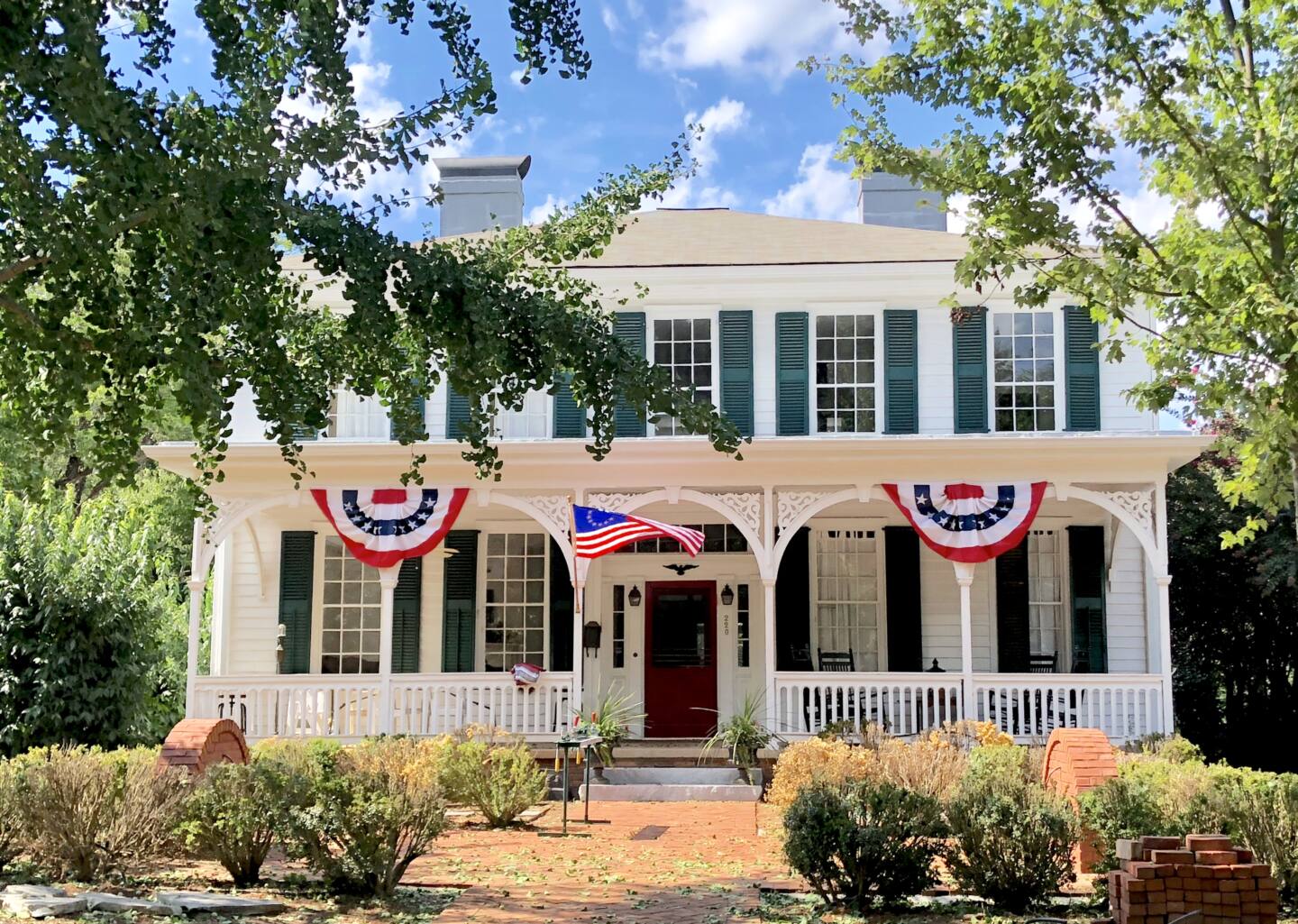
📅 The Gist: Over 50 historic homes and sites in Athens and Watkinsville will be accessible for tours during the Georgia Trust Spring Ramble, April 19-21.
🏠 The Details: This unique event, orchestrated by the Georgia Trust for Historic Preservation, invites you to explore private residences and historic locations typically closed to visitors. Highlights include the Young Harris House in Athens and the home of the late Vince Dooley in the Five Points area. The weekend also promises special dining experiences at iconic sites like Herty Field and the Taylor-Grady House.
🔢 By The Numbers:
- Over 50 historic homes and sites open for tours.
- 3 days of events from April 19 to April 21, 2024.
- 2 annual Rambles organized by the Georgia Trust for Historic Preservation.
🌍 The Big Picture: The Georgia Trust for Historic Preservation, since its founding in 1973, has been a pivotal force in preserving Georgia’s rich historical fabric. Through events like the Spring Ramble, it not only raises awareness of the state’s architectural and historical heritage but also encourages community engagement in preservation efforts.
🤔 Why It Matters: For locals and visitors alike, the Spring Ramble offers an exceptional opportunity to connect with Georgia’s history through direct experience of its preserved homes and sites. It emphasizes the importance of historical preservation in maintaining community identity and heritage.
🚶 What’s Next?: Attendees can look forward to a packed itinerary that includes tours of historic districts in Athens on Friday and Saturday, and a scenic outing to Watkinsville on Sunday, complete with brunch and historic farmstead visits.
Disclosure: This article may contain affiliate links, meaning we could earn a commission if you make a purchase through these links.
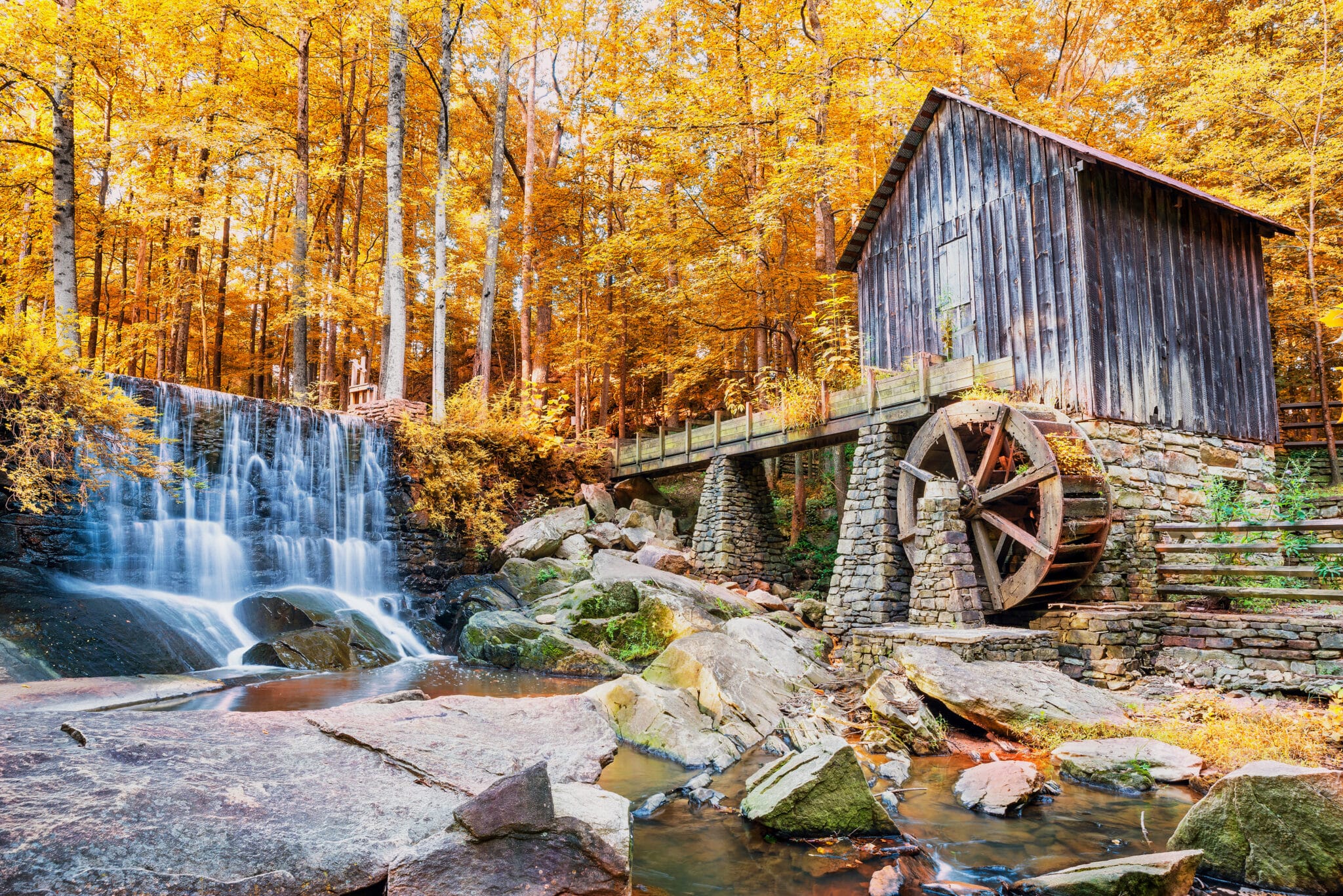
Fall Forecast: Expect wet weather in Georgia
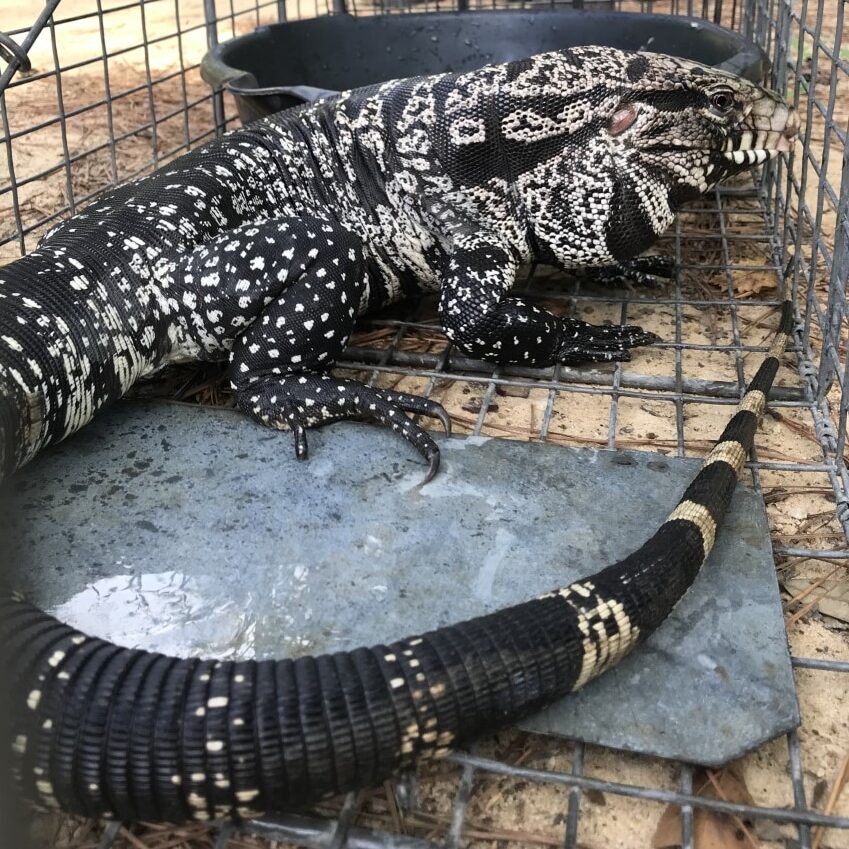
Invasion Alert: Argentine Tegus Lizard Threatens Georgia Wildlife

This Retired Braves Player Just Needs One More Day on The Roster to Qualify For a Pension
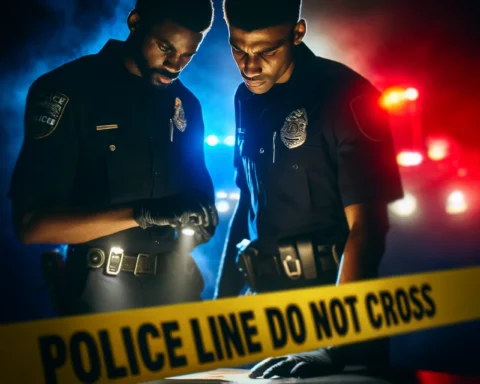
Fatal Shooting in Bibb County Under Investigation After Porch Gathering Turns Deadly

Major Roadwork Project on I-575 to Impact Traffic Starting Sunday
Events calendar, georgia newswire.
- Skip to main content
- Skip to secondary menu
- Skip to primary sidebar
- Skip to footer
This Is My South
A travel guide to the Southern USA
11 Historic Homes in Savannah You Can Actually Visit
February 10, 2020 By Caroline Eubanks Leave a Comment
Savannah , Georgia has one of the nation’s most carefully preserved historic districts. And it wouldn’t have been possible without some forward-thinking residents who saved historic homes from being bulldozed in the 1960s.
Some historic homes are managed independently while others are handled by the Historic Savannah Foundation . Like in Charleston , you can now visit many of these homes, which have been turned into museums, inns, and even restaurants.
Additional private homes are open on seasonal tours of homes. Visit Savannah has great information on historic homes.
A Note On Plantations: These homes have a dark history that shouldn’t be ignored. Only you can decide whether this is something you’re interested in doing. Read this post for more perspectives on both sides of the debate.
This post contains affiliate links.
Savannah House Tours and Tickets
Each of these homes has its own ticketing process, but you can also purchase combination tickets to see more than one. For example, Old Town Trolley Tours has a package that includes admission to the Davenport House and the Andrew Low House. The Owens-Thomas House can be visited in conjunction with the Telfair Museums.
Historic Savannah House Museums
Harper-fowlkes house.

The Harper Fowlkes House is a Greek Revival historic home dating back to 1842. It was saved by preservationist Alida Harper Fowlkes, who bequeathed it to the Society of the Cincinnati in the State of Georgia in 1985.
The home is known for its antiques, with items like 19th-century china, early portraiture from colonial Georgia , and Rococo sculptures. Fowlkes was herself an antiques dealer. The gardens are also stunning.
They operate tours on Monday and Wednesday to Saturday from 10 am to 4 pm. They also allow you to make appointments. Tickets cost $12 for adults, $6 for students, and free for those under 12. The Harper Fowlkes House is located at 230 Barnard Street, near Orleans Square.
Davenport House

The Davenport House Museum was one of Savannah ‘s first historic house museums and the Historic Savannah Foundation was created solely to save it from demolition. Built in 1820, the two-and-a-half-story brick structure was the home of Isaiah Davenport, his family, and his slaves.
In 1955, the home was nearly demolished to make room for a parking lot. The gardens have been partially restored to feature the plants of coastal Georgia that would have existed during the Davenports’ time.
Tours run Monday to Saturday from 10 am to 4 pm and Sunday from 1 to 4 pm. They last around 40 minutes and the garden is self-guided. It’s also a popular stop for a Savannah ghost tour .
Tickets are $9 for adults, $5 for children, and free for those under 6. The house is located at 324 E. State Street, near Columbia Square.
Andrew Low House

The Andrew Low House was built in 1848 in the Italianate style for the self-made Scottish immigrant. He became Savannah’s wealthiest citizen through the cotton trade. Over the years, his lavish home hosted Robert E. Lee and the Earl of Roxbury.
The house was owned by his descendants until the death of his daughter-in-law, Juliette Gordon Low, who had a house nearby. The National Society of The Colonial Dames of America in the State of Georgia purchased it in 1928 and it opened to the public in 1950.
Tours are offered on Monday to Saturday from 10 am to 4 pm and Sunday from 12 to 4 pm. Tickets are $12 for adults, $11 for seniors, AAA and AARP members, and Girl Scouts, and free for active military. The Andrew Low House is located at 329 Abercorn Street, around the corner from the Cathedral of St. John the Baptist.
Visit on the Garden & Historic Homes Tour , which stops by the Low, Mercer, and Green Houses.
Juliette Gordon Low Birthplace

The Juliette Gordon Low Birthplace was the home of the founder of the Girl Scouts, Juliette Gordon Low. She was born at the home in 1860 and lived here for most of her life growing up. She returned later in life when her husband died.
In 1912, she got the idea of the Girl Scouts of America here. Girl Scout troops from all over the world visit the home, which includes much of the house’s original furnishings. In 1953, the home was purchased by the GSA to operate as a museum. Exhibits include early uniforms from the troops.
Tours run around 40 minutes and cover Low’s life and areas of the home. Tickets are $12 for adults, seniors, students, and military, $10 for Girl Scouts, and free for children under 4.
Tours run every Monday to Saturday but tour times vary. The Juliette Gordon Low Birthplace is located at 10 East Oglethorpe Avenue, south of Wright Square.
Mercer-Williams House

The Mercer-Williams House was built in the Italianate style in the 1860s for General Hugh W. Mercer, the great-grandfather of acclaimed songwriter Johnny Mercer. But a few years later, it was sold to John Wilder.
In 1969, the most famous owner, Jim Williams bought the property. It was here that Williams murdered Danny Hansford, featured in “The Book” Midnight in the Garden of Good and Evil . Williams painstakingly restored the home and furnished it with antiques he’d collected over the years.
The house then passed to his sister Dorothy Kingery, who continues to live in the home and support restoration efforts. Tours operate from around 10:30 am to 4:10 pm Monday to Saturday and 12 to 4 pm on Sunday.
Tickets are $12.50 for adults and $8 for students. The Mercer-Williams House is located at 429 Bull Street, right on Monterey Square.
Visit on the Midnight in the Garden of Good and Evil Walking Tour of Savannah , which discusses the importance of the home in the book and subsequent movie.
Flannery O’Connor Childhood Home

Acclaimed author Flannery O’Connor lived in Savannah from 1925 to 1938 when she moved to Milledgeville . The Flannery O’Connor Childhood Home now operates as a museum on her life after her cousin, and neighbor, Katie later purchased the home.
It’s been restored to how it would have looked when the family lived here thanks to generous contributions from director Jerry Bruckheimer. The home also hosts lectures including past talks by authors Pat Conroy and Roxane Gay.
The home is open for tours Monday to Wednesday and Thursday to Sunday from 1 to 4 pm. Guided tours last 30 minutes and are $8 for adults, $6 for students and military, and free for children under 12. The Flannery O’Connor Home is located at 207 E Charlton Street, near Troup Square.
Green Meldrim House

The Green Meldrim House was built in the 1850s in the Gothic Revival style for English cotton merchant Charles Green. In 1864, Mr. Green invited General Sherman to use the home as Union headquarters during the occupation of Savannah during the Civil War.
It was passed to Green’s son in 1881 and in 1892, the house was purchased by Judge Peter W. Meldrim. His family continued to own it until 1943 when the Green Meldrim House to the neighboring St. John’s Episcopal Church. It now operates as their Parish House.
Tours are operated on Tuesdays, Thursdays, and Fridays from 10 am to 4 pm and Saturdays from 10 am to 1 pm. Tickets are $10 for adults and $5 for students. The Green Meldrim House is located at 14 W Macon Street, right on Madison Square.
Owens-Thomas House & Slave Quarters

The Owens-Thomas House was built in 1816 in the Regency style for merchant Richard Richardson and his family and slaves. The family suffered financially and sold it.
In 1824, Mary Maxwell operated it as a boarding house. It’s most well known for being where the Marquis de Lafayette gave a speech to the locals during his stay.
By 1830, it was the home of Mayor George Welshman Owens and later, granddaughter Margaret Gray Thomas. It became a museum in 1954.
It had the first indoor plumbing in the country, created by architect William Jay, who went on to create homes in Charleston and his native England.
Tours are offered from Tuesday to Saturday from 10 am to 5 pm and Sunday to Monday from 12 to 5 pm. Tickets are $20 for adults, $18 for seniors and military, $15 for students, and $5 for children.
The 45-minute tours visit the carriage house, slave quarters, and cellar. The Owens-Thomas House is located at 124 Abercorn Street, on Oglethorpe Square.
Visit the home with the combination Owens Thomas House & Slave Quarters and Telfair Museums Ticket .
Scarbrough House at The Ships of the Sea Museum

The Scarbrough House was built in 1819 for William Scarbrough, the owner of the steamship Savannah , the first to cross the Atlantic Ocean. Built in the Greek Revival style, it is one of the earliest examples of this type of architecture in the South.
In 1820, Scarbrough was in great debt and his house and furnishings were sold to a relative. By 1878, it became a school for African American children and continued until 1962. It was abandoned for a time before being restored by the Savannah Historic Foundation.
In 1995, it was acquired by the Ships of the Sea Museum and completely restored, including the portico and garden. Today the museum has pieces like models of the Wanderer and Titanic as well as maritime antiques.
The museum is open Tuesday to Sunday from 10 am to 5 pm. Admission is $9 for adults, $7 for students, seniors, military, and AAA members. Children under 5 are free.
The Scarbrough House at the Ships of the Sea Maritime Museum is located at 41 Martin Luther King Jr. Boulevard, just a few blocks from River Street.
Visit the William Scarbrough House with the Ships of the Sea Maritime Museum Self-Guided Tour .
Sorrel-Weed House

The Sorrel-Weed House was built for French Haitian merchant Francis Sorrel in the 1830s in the Greek Revival style. The site was where the Battle of Savannah took place in 1779. The Sorrel family lived there through the Civil War and even hosted Robert E. Lee.
Local businessman Henry D. Weed purchased the house in 1862 and it remained in his family until 1914. The home opened to the public in 1940 and features antebellum antiques. It’s also been featured on the show Ghost Hunters for its dark history.
Architecture and ghost tours are offered daily, lasting sixty minutes, and vary based on the tour type. Tours are $10 for adults and $6 for children. The Sorrel-Weed House is located at 6 W Harris Street, north of Madison Square.
Telfair Academy

The Telfair Academy was built in 1819 as a Neoclassical mansion from architect William Jay, who worked on many Savannah homes. Alexander Telfair lived here until passing it on to his sister Mary, who turned it into an art museum.
Opened in 1886, it’s the oldest public art museum in the South and the first museum in the United States founded by a woman. The collection includes American and European works from the Telfair family. The most well-known piece is the Bird Girl, which graced the cover of Midnight in the Garden of Good and Evil .
Tours are offered from Tuesday to Saturday from 10 am to 5 pm and Sunday to Monday from 12 to 5 pm. Tickets are $20 for adults, $18 for seniors and military, $15 for students, and $5 for children. Telfair Academy is located at 121 Barnard Street, south of namesake Telfair Square.
Historic Savannah Restaurants
Some of Savannah’s historic homes and buildings have taken on a new life as restaurants.
The Pirate’s House

The Pirate’s House was built around 1753 on the site of the Trustee’s Garden, an early agricultural project. The building itself is said to be one of the oldest standing structures in the state and the oldest continuously operating restaurant.
It became a tavern and boarding house, hosting seafaring pirates and even Robert Louis Stevenson stayed here while working on Treasure Island .
The building fell into disrepair but was saved in 1945 by Mary Hillyer, wife of the Savannah Gas Company owner. In 1953, it opened as a tea room.
Today the popular restaurant has some of the best fried chicken anywhere, not to mention a stellar Southern food buffet. The Pirate’s House is located at 20 East Broad Street, right off River Street.
The Olde Pink House

The Olde Pink House is one of the most well-known restaurants in Savannah, set in a Colonial mansion. It was built in 1771 as the Habersham House for James Habersham Jr., who lived here until 1800. It later operated as a bank and then Union headquarters during the Civil War.
Preservationist Alida Harper Fowlkes not only restored ten homes but also operated The Georgian Tea Room in the basement of the Pink House in 1929.
In 1992, it became a restaurant serving traditional Southern food. The Olde Pink House is located at 23 Abercorn Street, right on Reynolds Square.
Historic Savannah Inns and Bed and Breakfasts

Many of these formerly private homes now operate as Savannah’s historic inns and bed and breakfasts .
The Hamilton-Turner Inn was built in 1873 for businessman Samuel Pugh Hamilton near Lafayette Square. In 1915, it was sold to Dr. Francis Turner and in the 1960s it was saved from demolition. Today the home has 17 rooms with clawfoot tubs.
Kehoe House, Historic Inns of Savannah Collection near Columbia Square is one of Savannah’s finest properties. Built in 1892 for William Kehoe, it was also saved from demolition before becoming an inn in 1990.
The Alida Hotel is a newly built boutique hotel overlooking River Street, named for Alida Harper Fowlkes. It has trendy rooms, a restaurant, and three bars.
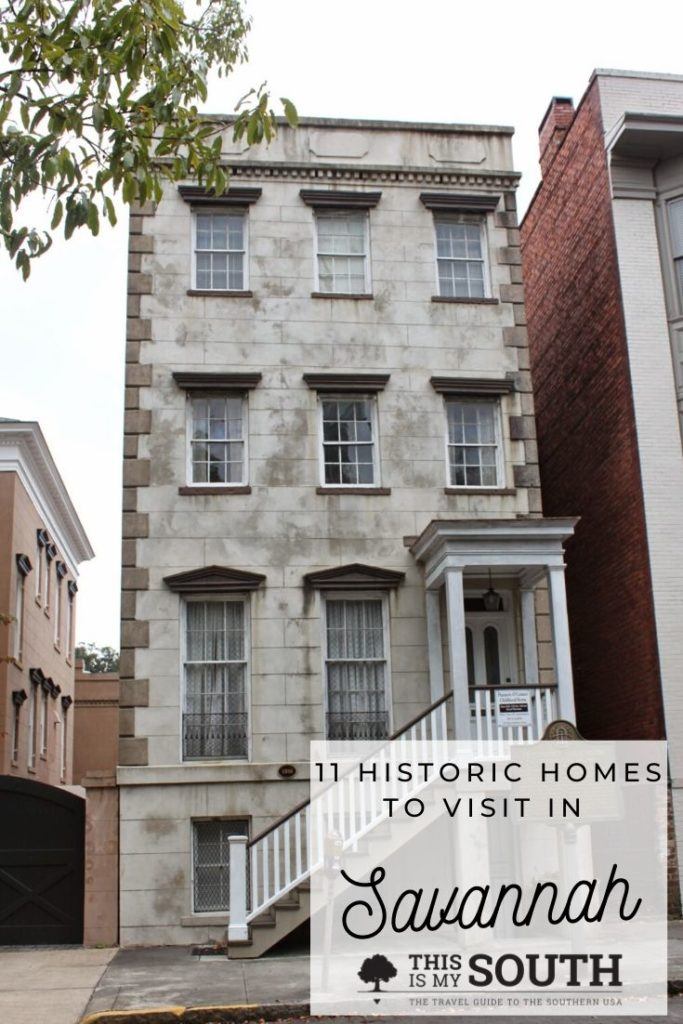
About Caroline Eubanks
Caroline Eubanks is the editor of this website, a Lowell Thomas award-winning travel writer, and the author of This Is My South: The Essential Travel Guide to the Southern States. Her stories from the South have appeared in National Geographic Traveler, Afar, Thrillist, Roads and Kingdoms, and BBC Travel.
Reader Interactions
Leave a reply cancel reply.
This site uses Akismet to reduce spam. Learn how your comment data is processed .
This Is My South is a participant in the Amazon Services LLC Associates Program, an affiliate advertising program designed to provide a means for us to earn fees at no cost to the consumer by linking to Amazon.com and affiliated sites. For further information, visit our Privacy Policy page.
This site is managed by Reggio Digital .
- Entries feed
- Comments feed
- WordPress.org

- Share full article
For more audio journalism and storytelling, download New York Times Audio , a new iOS app available for news subscribers.
How One Family Lost $900,000 in a Timeshare Scam
A mexican drug cartel is targeting seniors and their timeshares..
This transcript was created using speech recognition software. While it has been reviewed by human transcribers, it may contain errors. Please review the episode audio before quoting from this transcript and email [email protected] with any questions.
Hello, James.
Hey. How’s it going?
Yeah. I’m not having much luck. So the problem is funding. And all of my money is in Mexico, all of it.
From “The New York Times,” I’m Katrin Bennhold. This is “The Daily.” A massive scam targeting elderly Americans who own timeshare properties has resulted in hundreds of millions of dollars sent to Mexico.
Once you move forward and make your payment, if anything were to happen, he will directly pay you the full amount of what you’re entitled to, including the gains. He will pay you the full amount.
You’ve got all my money. It’s been sent. I sold a freaking house.
Listen to this. I sold a house that I grew up in so that I could come up with funds to send to Mexico.
I don’t even have anything from the sale, nothing.
My colleague Maria Abi-Habib on one victim who lost everything and the people on the other side of the phone.
That’s it. That’s it. There’s nothing —
You know what? That’s what has been said every freaking time. Every time, just pay this. That releases the funds.
But that’s why we won’t allow it to happen again. This is the last time, James.
It’s Friday, April 12.
Maria, you’ve been looking into this scam that’s targeting Americans. Where did your investigation start?
So several weeks ago, I received a phone call from a lawyer based in St. Petersburg, Florida, who had been contacted by a family who was very concerned that the father, this man named James, was in the middle of being scammed. He’d sent hundreds of thousands dollars to Mexico. And he was considering sending another $157,000 when his daughter decided to call up this law firm and try to get her father to stop, stop sending money to Mexico.
So I called him a few weeks ago as I was trying to understand what was going on.
Hi, James. How are you?
Good. Thank you.
He’s asked that his last name be withheld for privacy concerns because he’s quite embarrassed about the story that I’m about to tell you.
You’re retired now, but what were you doing for work? And if your wife was working, what was her job?
I was with the Highway Patrol.
James is a retired state trooper from California. And his wife Nikki is a former school nurse.
She was born in ‘51. So 71-ish.
Two. She’s just reminded me, 72.
And they’re both in their early 70s. And they own this timeshare that is in Lake Tahoe, California. And they bought it in the 1990s for about $8,000.
And for someone who did not grow up vacationing in a timeshare, remind me how exactly timeshares work.
Timeshares are essentially vacation properties. And they tend to be beach resorts. And multiple people can buy into this property. The ownership is a shared ownership. And this gives you the right to use the timeshare for one to two weeks out of every year.
And so James and Nikki used their timeshare every other year with their daughters. But as they hit retirement age and their daughters are growing up and starting their own families, they’re just not really using it that much anymore. And timeshares require the owners to pay off yearly maintenance fees. And so they’re starting to think about maybe letting go of their timeshare and selling it.
Then one day, in late 2022, James gets a phone call from a company that is purporting to be based out of Atlanta, Georgia called Worry Free Vacations.
Worry Free Vacations?
That sounds enticing.
Yeah. And they start off with a simple question, which is, do you want to buy a timeshare? And James says, I already have a timeshare. And then they say, great. Well, what about selling the timeshare? Do you want to sell? There’s this Mexican businessman, and he’s interested in your timeshare. And he’s willing to buy it for about $20,000.
So we figured, well, what the heck? If we can make a few bucks on it, we’ll go for it.
And James jumps at the opportunity.
And did he do anything to try and verify that this was real?
Yeah. So remember, James is former law enforcement. And he feels very confident in his abilities to sniff out untrustworthy people. So he goes online, and he googles this Mexican businessman and sees that, yeah, he is a real person.
He’s a very well-respected individual in Mexico, very well off. And —
And this makes James feel at ease, that he’s selling to a legitimate person, that Worry Free Vacations are who they claim to be and that he’s going to double his money overnight, essentially.
And what happens next?
Well, a couple of weeks after he makes the agreement with the buyer, he’s told that he needs to send a couple thousand dollars to facilitate the purchase.
What does that mean, facilitate?
[MUSIC PLAYING]
I can’t remember specifically whether it was supposed to be cross-border registration —
So he’s being told that there are these fees that are paid directly to the Mexican government.
Or SPID or some other fee that was Mexican government required or not.
A lot of these fees are the same types of fees that you would pay in the United States for a real estate transaction. So he begins wiring money to an account in Mexico.
After that —
— a few days later, we get a notification. Well, everything went well, except that we have to pay an additional fee.
Every time that he sends one fee, he’s being told that he’s got to send another fee right afterwards.
Does he get suspicious at any point?
His wife is suspicious. After the first couple of payments, she starts saying, this does not feel right.
But James is the former law enforcement officer, right? And he’s the one that basically handles the family finances. And he’s confident that all of this is going to work out because he’s being told that the buyer of the timeshare will reimburse James for all of these fees once the sale goes through.
Michael from the Worry Free Vacations was constantly reassuring me the money’s in that account. Check with the commercial escrow account. It’s there. It’s just these fees have to be paid, and you’re being reimbursed for all of this.
They’re sending James documents that show all of the reimbursements that he’s owed and how much money he’s going to get. And this just makes him feel like all of this is kosher.
We have this commercial escrow company that was involved out of New York. So there was an air of legitimacy that I was comfortable with.
Maybe OK, these guys just need one more fee and everything is going to finally be cleared.
But about a year in, James starts to get suspicious. He begins asking questions because he wants his money.
And every time I asked, hey, is there a way I can get a partial release of these funds, there was always no, these funds have to be paid from your account before they’re released.
But Worry Free Vacations, they pivot. And they tell him that, listen, there are all these complications. It’s going to be really hard to get your money out from this transaction.
I could pay about $30,000 and change to reinvest the $313,000 into an environmentally-conscious development in Loreto, Mexico.
Instead, we’ve got this other investment opportunity in Mexico.
And I’m sure you know where that is, over on the East Coast of Baja.
And that is going to make you a huge return, even more money than you had thought that you were going to make, much more than the $20,000.
I’m supposed to have 54 million pesos in a Mexican bank account.
So this is now no longer just about his timeshare. They are now partners in a real estate investment.
Right. And there’s this whole new round of fees and fines associated with that.
So how many payments would you say?
Quite a few. Couple dozen at least, maybe more.
When was your last payment?
It would have been 17 January.
Uh-huh. And what was that for?
Good question.
And all along, he believed it was necessary to pay these costs just to get the money that he’s owed.
The amount of money that I’ve sent to Mexico is just freaking exorbitant. And I mean, it is approaching $900,000 or more.
And at this point, he’s sent about $900,000 to Mexico over about a year and a half.
Nearly $1 million.
That was almost all the money that he and his wife had saved for their retirement.
It also included money from the sale of James’s childhood home and money that he had borrowed from his daughter and son-in-law, about $150,000 from them.
It’s awful. So they were completely cleaned out by these guys.
Yeah. And this is when his daughter asks a law firm to look into this, which is the point in the story when I meet James. And when we start talking, it was clear to me that he just did not know what to think, even after losing this much money.
So this started in 2022. When did it end?
We’re still in it.
And he’s still talking to the scammers.
And as a matter of fact, presently, there was a request for $157,000 and change to clear up this whole thing. It would clear the entire issue out. Now —
And James is even considering putting a second mortgage on his house to send that money that he’d been promised would finally clear all this up — one final payment of $157,000.
It really sounds like he’s still wanted to believe that this was somehow legit.
Yeah. It was pretty clear to me that he was being scammed. But I didn’t definitively know what was going on, so I asked him if he could start recording his phone calls with the scammers.
Would you be so kind as to do me a favor?
Would you be willing to give them a call and record them?
[LAUGHS]: I’ll let you in on a little secret. I’ve been recording them.
And it turns out he already had been.
Worry Free Vacations.
So he shared the recordings of these calls that he’d had with these scammers over the last year or so. And it was just remarkable. It gave me huge insight into how the scam worked and the way that it sounded over the phone.
Is this is Michael in? I think he’s trying to call me. I couldn’t get through pick up.
Yes, I believe he did try to call you, sir. Give me a second. I think he’s only going to be in for a couple of minutes. One second.
There are two main takeaways for me listening to these calls.
Good afternoon. Michael McCarthy.
Michael, I missed your call. I was trying to pick up.
Yeah, don’t worry. Yeah, I figured something was wrong with your phone. Everything OK?
The first is that these scammers had really gotten to know James so well, and they really made James believe that Worry Free was a company that was working for him.
That’s why we need to hurry up and get this money over to you. Because hey, I’m losing my mind too. I’m not even here to convince you, James. I’m not — I’m your broker, and —
One of the things they continuously say is, trust me.
Look, I’m doing everything I can in my power and will on my end. So James, just look — like I told you from the get-go, I’m going to resolve this. And we are doing it. I just need you to focus on the goal.
They would refocus the conversation on what James needed to do to get his money back.
Look, if you make your payment as a security deposit, right away they will release the funds to you. With these —
And the other thing —
I’ve been having so much trouble trying to reach you, and I have not been successful.
— is that the scammers had created this elaborate cast of characters.
Why don’t you answer my calls?
And some of them were really aggressive. James shared a recording of this one man who claimed to be an agent for the Mexican government. And he basically started yelling at James.
I don’t care if your wife is at the hospital. To be honest with you, I don’t give a damn! But you know where I do give a damn? It’s your money, and my name is written all over it! Do you understand?
And he even threatened James. If James didn’t pay off these fines, then he would lose all the money that he’d sent to Mexico already.
You could get the best lawyer you want. You could get whoever you want. And this is not a threat. This is facts. But anyways, who am I to convince you, right?
Well, thank you for the information. And — are you still there? Hello?
Wow. So these scammers were basically doing a good cop, bad cop routine to stop James from walking away and to squeeze every last penny out of him.
If you provide me your email, contact information, I will certainly be happy to forward all of the wire transfer information from my bank account to you so that you can see where those funds went.
Yeah, that would be great. I have your email.
James asks me, a reporter who’s based in Mexico, who speaks the language, if I could help him figure out where his money had gone to.
Thank you very much. I really appreciate your assistance.
I’m just doing my job. Thanks again, and we’ll talk soon.
And the only way that I could figure that out was to understand who was on the other side of the phone.
We’ll be right back.
So Maria, who was on the other side of that phone line?
So by the time that I’d met James, I’d already gotten a tip from US law enforcement agencies that they were seeing a new trend. Mexican drug cartels were getting involved in the timeshare scam industry.
Drug cartels?
Yeah. And not just any drug cartel. This is one of the most notorious, violent, bloody drug cartels that exists in Mexico and Latin America, the Jalisco New Generation cartel. And when I looked at James’s bank records, guess what? All the money that he was sending was going to various bank accounts that were all located in Jalisco state in Mexico.
Wow. So why would the drug cartels get into the timeshare scamming business?
It is a huge business. The FBI told me that it’s about $300 million in profits over the last five years.
But the thing is is that the potential for it to actually be multitudes more is huge. Because the FBI estimates that most of the scams are actually not even reported. In fact, only about 20 percent are. So that means the total timeshare scam business could actually be much larger than the $300 million that they have knowledge of over the last five years.
But wait. I thought the drug business was a pretty lucrative business in itself. So why get into the scamming of elderly people for their properties in Lake Tahoe?
Well, you have to remember that these drug cartels, they’re not just doing one thing. They’re doing multiple things. They’re essentially conglomerates. Because it’s really expensive to run a cartel. You need to pay off officials, both Mexican and American. You need to maintain basically an army in order to secure your routes up to the United States, ports of entry into Mexico from Colombia. And any big business, you need to diversify your income to make sure that you keep the money flowing. Because you never know when one business is going to be shut down by authorities or taken over by your rivals.
We’ve reported that they’re now in the avocado business and the construction business. And timeshare fraud is basically no different than any of those. So we’re seeing that the cartels have their fingers in many pies, the legitimate and the illegitimate economy here in Mexico.
It’s kind of fascinating to think of these drug cartels as like sprawling diversified business empires. But when did the cartels first get into the scamming business?
So Jalisco New Generation started about 15 years ago.
And when they started to consolidate their empire in Jalisco state, they found that there were all these scam timeshare call centers all over the state that were being run by various players, and that this was a huge, huge moneymaker. Because essentially, all you have to do is call up retired senior citizens in the US and Canada. It doesn’t take that much money to run that kind of a scheme. There’s no product you’re making.
So essentially, they conducted a hostile takeover of these call centers. They went in. They kicked down doors and dragged out the people who were managing these call centers by their hair and threatened to kill them unless they gave up the call centers or started handing over a cut of what they made. And slowly, slowly Jalisco New Generation cartel took over the entire timeshare fraud industry.
Interesting. Were you able to find any of these call centers?
So these call centers are pretty hard to find. They look like any other storefront. But I was able to visit two that were located in an upscale neighborhood in Guadalajara, which is the capital of Jalisco state. And it was just really perturbing because it was just so normal. Two villas about a mile away from each other outside. Outside of one villa, parents were walking by, holding their children’s hands as they did drop off at school.
It was right next to a park where people taking their morning exercise or their dogs for a walk. There was no real sign that the cartel was doing business there. But a few months before, Mexican law enforcement had found the bodies of eight young people who had used to work at one of these call centers and said that the Jalisco cartel had killed them.
Wow. What happened?
So I wasn’t able to talk directly to any of the victims’ families. They’re just too scared. But in general, this is usually how it starts.
The cartel seeks out English speakers to work for their call centers. Sometimes they don’t even tell them what exactly they are doing. They would tell the recruits that the job was adjacent to the hotel industry.
You have to remember, Jalisco is a huge, huge tourism magnet for Americans and Canadians and others. And the cartel would get their call lists from bribing hotel employees to give them the names of people who stayed at these hotels and also at the timeshare resorts. And the people who would work at the call centers are provided the names and a manual of what you need to do when you call, like a loose script of how to try to suck as much money as you can out of these people up North in Canada and the States.
So we don’t know for sure what exactly happened with the eight young Mexicans who were killed last year. But through an intermediary, one sibling told us that when their family member knew what their job actually was, they became extremely uncomfortable and tried to leave the call center and find another job maybe.
But the Jalisco New Generation cartel is known for being extremely brutal. They chop off heads, and they’ll put them on the gates of a playground, for instance. So that everybody in the neighborhood knows what went down. And in this case, it’s possible that they wanted to send a warning that there’s no defection from their timeshare call centers.
So basically making a very scary example of these guys, in case anyone else is thinking about quitting one of the call centers.
Exactly. And one man, who runs an organization who advocates for missing people and actually organizes search parties to comb the forests of Jalisco state looking for the missing, says that he knows of about 30 people who have disappeared from the call centers in Jalisco state since 2017. So while Americans and Canadians might be losing much of their life savings, in Mexico, this is actually deadly.
Are the authorities doing anything about this?
Not really, other than the fact that these two call centers were shut down. The authorities haven’t arrested others. They’re not putting pressure on Mexican banks, for instance, to look into these payments coming from senior citizens in the US or Canada. And you have to remember that people are really afraid. But you also have to remember that in Mexico things are not that clear. There is a lot of corruption and government collusion with organized crime and cartels.
And the tourism industry, it is huge in Mexico and particularly in Jalisco state. This is a multi-billion dollar industry. They don’t want Americans or Canadians or Europeans who are coming to Jalisco for its beautiful beaches and its mountains to hear about these stories regarding the cartels being involved in the tourism industry and think, I’m not going to send my family there for that beach vacation. It’s just simply too dangerous.
So everybody has an incentive to have the scam continue, whether because they’re too afraid and don’t want to speak out or because they’re in on it.
So in a way, local authorities have an interest in sweeping it under the carpet in order to just maintain this idea of a tourist destination.
Exactly. I mean, the spokeswoman for the prosecutor’s office was very responsive to me until I told her what I wanted to ask her questions about. And then she just simply never answered any of my texts or phone calls.
So Maria, based on everything you know, all the information you have, would you say that you’re confident that the cartels were the ones who scammed James?
Yes, 100 percent. Everything I’ve seen points in that direction.
What did James say when you told him this?
So it took him quite a while to really allow himself to believe it. On the advice of his lawyers, he stopped picking up the phone calls. And about a week ago, they stopped after the scammers kept trying to call him.
But you said he was in it for over a year. Why do you think it took him so long?
Can you tell me, after all of that had been presented to you, why do you think you weren’t willing to be entirely convinced?
Well, I actually asked him that question.
That’s a very good question. Why wasn’t I able to pick up on that right away? And I think in the back of my mind, I’m finding out that I’m a little more stubborn than I thought I was.
And for him, it was pretty complicated.
And I think that I didn’t want to believe that I had fallen for this. I didn’t feel I was that foolish and stupid when it came to this. You know? I guess I didn’t want to believe that I could be fooled.
To come to terms with the fact that he had lost so much money was to come to terms with the fact that he wasn’t the person that he thought that he was, that he wasn’t this kind of clever former law enforcement officer who was used to fighting the bad guys and winning.
I’m disappointed in myself. There’s a huge level of anger towards the perpetrators. And all of those things wrapped into one. And part of that, I think, contributes to not wanting to actually believe that I was wrong.
Hmm. Yeah, I hear you. I’m sorry. I can hear the pain in your voice.
[LAUGHS]: Yeah.
Some of it’s based on shame, right? That he lost all this money, everything that he’s worked for, and the fact that this was all supposed to be money that his children and his grandchildren were going to inherit. And now it’s gone.
And have you told your daughter that you think you’ve come to terms with the fact that this might have been a scam?
Oh, she’s been involved. Yeah. They know.
My daughter does.
I’m sorry. This is a tough time.
So I’ve got to make some sort of arrangement to compensate them for this on top of our regular debt. So yeah. It’s been a swell experience, all of it brought on by my — evidently, my stubbornness to believe that I couldn’t possibly be a victim.
How’s your wife doing throughout this whole process, with this new knowledge?
She’s not real happy, obviously, at all. I hear a lot of “I told you so.” And at this point, I’ve got no defense. She’s absolutely right. There’s no question about it.
Do you worry this is going to affect your marriage?
Yes, there has been an effect.
And do you think that at this point there’s any way for James and his family to get some kind of justice or at least find some kind of closure?
Ay. Justice? Unlikely.
At this point, I’m not necessarily expecting much in the way of restitution.
And as for closure, it’s a little bit too soon to tell. In a way, James has gone through several stages of acceptance for what happened. There’s fear. There’s shame. There’s resignation. And now he’s talking to me partly because he feels like it’s a public service, that he needs to be vocal so that other people don’t go through what he’s gone through and fall for the scam. And I think it also helps him feel a little bit empowered in a situation for over the last year and a half he was at the mercy of these people who were calling him multiple times a week.
I want to try to get as much information to as many of these official organizations as possible. I have a streak of anger through me now that I’ve developed to the point where I’m not going to let this go.
Well, Maria, thank you.
Thank you for having me.
Here’s what else you need to know today. OJ Simpson, the football star who was accused and later acquitted of murdering his former wife and her friend, died of cancer at his home in Las Vegas, his family said Thursday. He was 76.
Today’s episode was produced by Astha Chaturvedi and Will Reid, with help from Clare Toeniskoetter and Lindsay Garrison. It was edited by Brendan Klinkenberg and Michael Benoist, contains original music by Marion Lozano, Rowan Niemisto, Dan Powell, Pat McCusker, and Will Reid, and was engineered by Chris Wood. Our theme music is by Jim Brunberg and Ben Landsverk of Wonderly.
[THEME MUSIC]
That’s it for “The Daily.” I’m Katrin Bennhold. See you on Monday.

- April 16, 2024 • 29:29 A.I.’s Original Sin
- April 15, 2024 • 24:07 Iran’s Unprecedented Attack on Israel
- April 14, 2024 • 46:17 The Sunday Read: ‘What I Saw Working at The National Enquirer During Donald Trump’s Rise’
- April 12, 2024 • 34:23 How One Family Lost $900,000 in a Timeshare Scam
- April 11, 2024 • 28:39 The Staggering Success of Trump’s Trial Delay Tactics
- April 10, 2024 • 22:49 Trump’s Abortion Dilemma
- April 9, 2024 • 30:48 How Tesla Planted the Seeds for Its Own Potential Downfall
- April 8, 2024 • 30:28 The Eclipse Chaser
- April 7, 2024 The Sunday Read: ‘What Deathbed Visions Teach Us About Living’
- April 5, 2024 • 29:11 An Engineering Experiment to Cool the Earth
- April 4, 2024 • 32:37 Israel’s Deadly Airstrike on the World Central Kitchen
- April 3, 2024 • 27:42 The Accidental Tax Cutter in Chief
Hosted by Katrin Bennhold
Produced by Asthaa Chaturvedi and Will Reid
With Clare Toeniskoetter and Lynsea Garrison
Edited by Brendan Klinkenberg and Michael Benoist
Original music by Marion Lozano , Rowan Niemisto , Dan Powell , Pat McCusker and Will Reid
Engineered by Chris Wood
Listen and follow The Daily Apple Podcasts | Spotify | Amazon Music
Warning: this episode contains descriptions of violence.
A massive scam targeting older Americans who own timeshare properties has resulted in hundreds of millions of dollars sent to Mexico.
Maria Abi-Habib, an investigative correspondent for The Times, tells the story of a victim who lost everything, and of the criminal group making the scam calls — Jalisco New Generation, one of Mexico’s most violent cartels.
On today’s episode

Maria Abi-Habib , an investigative correspondent for The New York Times based in Mexico City.

Background reading
How a brutal Mexican drug cartel came to target seniors and their timeshares .
There are a lot of ways to listen to The Daily. Here’s how.
We aim to make transcripts available the next workday after an episode’s publication. You can find them at the top of the page.
The Daily is made by Rachel Quester, Lynsea Garrison, Clare Toeniskoetter, Paige Cowett, Michael Simon Johnson, Brad Fisher, Chris Wood, Jessica Cheung, Stella Tan, Alexandra Leigh Young, Lisa Chow, Eric Krupke, Marc Georges, Luke Vander Ploeg, M.J. Davis Lin, Dan Powell, Sydney Harper, Mike Benoist, Liz O. Baylen, Asthaa Chaturvedi, Rachelle Bonja, Diana Nguyen, Marion Lozano, Corey Schreppel, Rob Szypko, Elisheba Ittoop, Mooj Zadie, Patricia Willens, Rowan Niemisto, Jody Becker, Rikki Novetsky, John Ketchum, Nina Feldman, Will Reid, Carlos Prieto, Ben Calhoun, Susan Lee, Lexie Diao, Mary Wilson, Alex Stern, Dan Farrell, Sophia Lanman, Shannon Lin, Diane Wong, Devon Taylor, Alyssa Moxley, Summer Thomad, Olivia Natt, Daniel Ramirez and Brendan Klinkenberg.
Our theme music is by Jim Brunberg and Ben Landsverk of Wonderly. Special thanks to Sam Dolnick, Paula Szuchman, Lisa Tobin, Larissa Anderson, Julia Simon, Sofia Milan, Mahima Chablani, Elizabeth Davis-Moorer, Jeffrey Miranda, Renan Borelli, Maddy Masiello, Isabella Anderson and Nina Lassam.
Katrin Bennhold is the Berlin bureau chief. A former Nieman fellow at Harvard University, she previously reported from London and Paris, covering a range of topics from the rise of populism to gender. More about Katrin Bennhold
Advertisement

IMAGES
VIDEO
COMMENTS
The 28th U.S. president lived in Augusta during the Civil War and Reconstruction. The Boyhood Home of President Woodrow Wilson was built in 1859, and during tours you can see a window where Wilson etched his name as a child. Visit President Wilson's Boyhood Home. The Little White House in Warm Springs, Georgia.
The Twelve Oaks is now open book your dream room today. The home that inspired Twelve Oaks in Gone with the Wind is now reopen! We plan to offer historic tours of the mansion and grounds making this the only antebellum home of this size that you can tour in the Atlanta area. Explore Georgia named the Twelve Oaks as one of the top antebellum ...
The Antebellum Trail is a historic odyssey through Georgia towns that escaped burning during Sherman's March to the Sea. Our four day package visits Antebellum homes; teaches you about architecture and art, you explore Pre-Civil War mansions, browsing through antique shops, dine on southern delicacies and learn about the Old South. Details.
Recreational Areas. February 17, 2024. Embark on a fascinating exploration into the heart of Savannah, Georgia, where the grandeur of Antebellum Homes Savannah captures the essence of a bygone era. These historic homes in Savannah, Georgia, stand as proud monuments to historic preservation and the enduring allure of Southern architecture.
Open in Google Maps. 935 High St, Macon, GA 31201. (478) 743-3851. Visit Website. Courtesy of Visit Macon. Reaching from Athens to Macon, within a couple hours of Atlanta, the trail offers ...
Bellevue, a stately antebellum home, was built between 1852 and 1855 by Benjamin Harvey Hill and is open for tours. Bellevue, a stately antebellum home, was built between 1852 and 1855 by Benjamin Harvey Hill for his wife, Caroline Holt Hill. ... Located in historic downtown LaGrange, Georgia, Bellevue became the home of the LaGrange Woman's ...
We are excited to have you visit our historic home. Stately Oaks is a plain Greek Revival antebellum home located in Clayton County, Georgia, " The Home of Gone with the Wind.". Along with the main house, guests may tour the original cook's log cabin, one-room schoolhouse, Creek Indian Village, Juddy's Country Store, and much more.
Barrington Hall 535 Barrington Drive Roswell, GA 30075 770-640-3855. Bulloch Hall 180 Bulloch Avenue Roswell, GA 30075 770-992-1731. Smith Plantation 935 Alpharetta Street Roswell, GA 30075 770-641-3978. Back to the top. Self-guided tours of the grounds of Barrington, Bulloch and Smith, a trio of antebellum homes in Roswell, Georgia.
Peek back in time to the days of white columns and grand front porches preserved in these seven communities. Experience the roots of Southern hospitality through 19th-century homes along Georgia's Antebellum Trail, spanning 100 miles and seven historically significant communities: Athens, Watkinsville, Madison, Eatonton, Milledgeville, Gray/Old Clinton, and Macon.
Owens-Thomas House & Slave Quarters Tours. Guided tours are given at 15-minute intervals. The last tour begins at 4:00pm. Tours typically last around 45 minutes to an hour. Tour groups consist of up to 12 people. Please check in onsite to get a tour time, even if you've purchased tickets at our other two sites.
Driving the backroads of Georgia. Oct 2021. Georgia's Antebellum Trail is a three-day, 100-mile trek though seven historic communities that escaped Sherman's burning March to the Sea during the closing months of the Civil War and today provide a window to the rich history of the Old South. The drive from Athens to Macon is full of historic ...
Wendy K. Leigh, Leaf Group. The Antebellum Trail in Georgia spreads 100 miles, highlighting seven communities east of Atlanta, from Macon to Athens. When General Sherman made his fiery march ...
3-Hour Private Atlanta MCU Comics Inspired Film Location Tour. 54. from $175.00. Atlanta, Georgia. Sweet Auburn Famous Food & History Tour. from $275.00. Likely to Sell Out. Atlanta, Georgia. 90-Minute Narrated Sightseeing Trolley Tour in Atlanta.
Located in Thomasville, Georgia, this antebellum plantation and museum was first established when Thomas Jefferson Johnson purchased the land in 1825. Johnson first raised cotton and then introduced rice, a profitable crop in Georgia during the 19th century. ... take a tour of the magnificent plantation home and let the kids enjoy the petting ...
Historic homes in Savannah, including details of house tour hours, admission cost and other information. ... (today owned by the Colonial Dames of Georgia) has numerous restored rooms showing how life would have been for a wealthy Savannah family in the 19th century, including a children's playroom and, more unusually, one of the earliest ...
Built in 1830, the T.R.R. Cobb House was home to Thomas Cobb, the founder of the University of Georgia School of Law, soldier, and signer of the Confederate Constitution.. The house was sent to Stone Mountain, Georgia to be an attraction at the park in 1984, but was finally moved back to its nearly original home and restored in 2007. The home is open from Tuesdays to Saturdays from 10 am to 4 ...
Timeless Beauty. Named by Southern Living Magazine as one of the "Prettiest Small Towns in Georgia," Washington boasts more antebellum homes per capita than any other town in America. We invite you to step into southern antiquity as you stroll our tree lined sidewalks during our 2024 Spring Tour of Homes and Art Show.
Milledgeville-Baldwin County. Convention & Visitors Bureau. 200 W Hancock St. Milledgeville, GA 31061. Milledgeville, GA is rich in history and boasts an assortment of historic sites. Tour Georgia's Old Governor's Mansion or walk through an Antebellum home.
The Georgia Trust Spring Ramble. Athens, Georgia. April 19-21, 2024. Please make your reservations right away and remember to mention you are with The Georgia Trust to get these rates. Prices do not include taxes. Best Western Athens. 170 N. Milledge, Athens. 706-546-7959. $159/$169 + tax per night.
Try out our personalized tour creator tool for historic home tours in Macon, GA. Lights on Macon offers flexible routes suited to you. 0 -5 .5 1 top 80% 1 0 .75 .001 .1 1 1.1 20 Expo.out 0 0 top 10% 1 0 1 linear 0 .1 1 bottom 70% play none none reset 1 2 .1 .15 1.25 10 none
Highlights include the Young Harris House in Athens and the home of the late Vince Dooley in the Five Points area. The weekend also promises special dining experiences at iconic sites like Herty Field and the Taylor-Grady House. 🔢 By The Numbers: Over 50 historic homes and sites open for tours. 3 days of events from April 19 to April 21, 2024.
The Harper Fowlkes House is a Greek Revival historic home dating back to 1842. It was saved by preservationist Alida Harper Fowlkes, who bequeathed it to the Society of the Cincinnati in the State of Georgia in 1985. The home is known for its antiques, with items like 19th-century china, early portraiture from colonial Georgia, and Rococo sculptures.
For this reason, Newnan is known as "The City of Homes.". We saw some gorgeous historic homes on the tour. The following pics were all taken of the beautiful Victorian home you see below. I believe this home is designed in the Second Empire (Mansard) style. I just discovered today (Saturday) that this home is also, for sale for $1,490,000.
Scenes from the 2024 April in Talladega events including some of the historic home tours, Heritage Hall's Art on the Lawn event, and the Family Block Party on Saturday, April 13.
A Mexican drug cartel is targeting seniors and their timeshares. Hosted by Katrin Bennhold. Produced by Asthaa Chaturvedi and Will Reid. With Clare Toeniskoetter and Lynsea Garrison. Edited by ...